Summary of each archaeological site
Jomon Prehistoric Sites in Northern Japan
The Jomon Prehistoric Sites in Northern Japan span 10,000 years of history. They tell the story of Japan’s prehistoric people, from the earliest use of pottery to the emergence, development, and maturity of sedentism. Artifacts unearthed at the sites demonstrate a sophisticated design sense and provide evidence of trade between communities. They include lacquered bracelets, jade beads, clay figurines (dogu) with expressive facial features, and ornate earthenware vessels in a multitude of styles. Each site has yielded new discoveries that shed light on life in prehistoric northern Japan.
Seventeen archaeological sites comprise the Jomon Prehistoric Sites in Northern Japan, and two additional locations are considered associated sites. The sites are defined by their diverse surrounding natural environments. They are located on the coast, beside rivers, and on hilltops. Most of the archaeological sites can be explored freely and many have on-site museums that display artifacts and introduce life in the Jomon period (13,000–400 BCE). Start at the earliest site, Odai Yamamoto, or begin by visiting a stone circle; the sites can be explored in any order.
(This English-language text was created by the Japan Tourism Agency.)
Odai Yamamoto Site
This prehistoric site on the Tsugaru Peninsula in northern Aomori yielded stone tools and some of Japan’s earliest pottery. The artifacts unearthed here show how life changed for northern Japan’s prehistoric peoples during the final phase of the Paleolithic period (Old Stone Age) and became more sedentary at the dawn of the Jomon period (13,000 BCE).
Stone tools and what they tell us

Axes, knife-like blades, scrapers for skinning animals and working wood, and sharp-pointed tools most likely used for hunting are among the stone tools unearthed at the Odai Yamamoto Site. They vary in shape and size, ranging from larger, more rudimentary tools to more technically refined blades and arrowheads, designed to hunt fast-moving animals such as deer.
Most of the tools are made from slate, which would have been available locally from nearby rivers. Analysis of the tools indicates diverse stoneworking techniques, including regional techniques associated with prehistoric sites in Hokkaido, as well as central Japan (Kanto). The variety of tools and techniques suggests significant interaction with other regions and communities.
Pottery and the transition to a new way of life
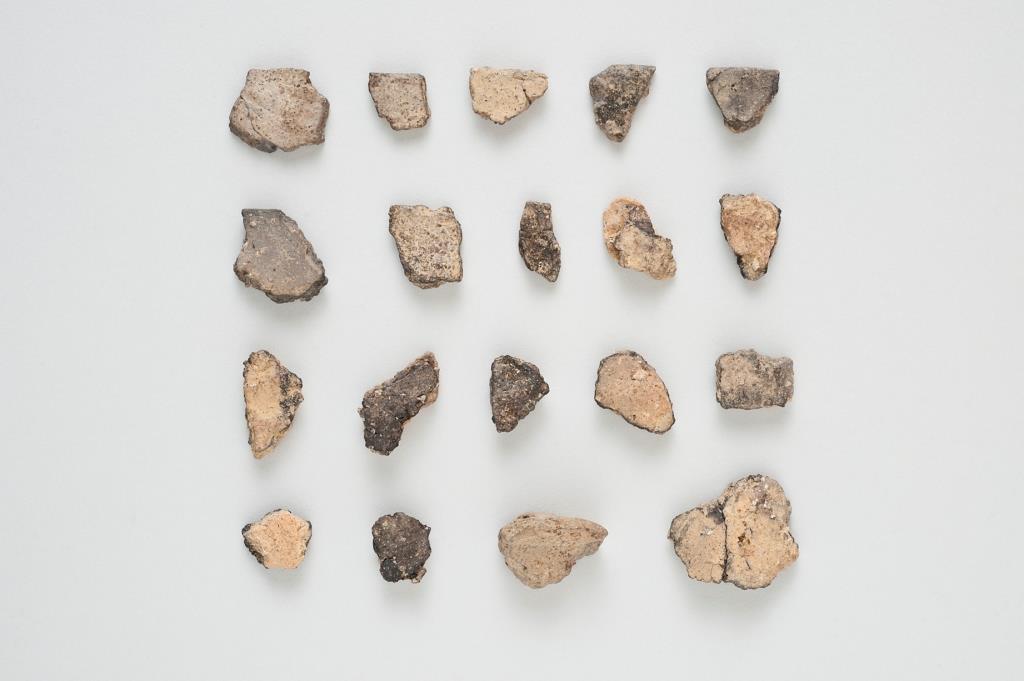
The earthenware fragments found at the Odai Yamamoto Site are among the oldest known in the world. A handful of the potsherds, believed to be from a single vessel, were found to have carbonized residues. Carbon dating of these fragments suggests they are from 13,000 BCE, thousands of years before pottery was being used in Europe or the Near East.
The Jomon period is named for the “cord-markings” that characterize the earthenware typical of this period, but the fragments found at the Odai Yamamoto Site have no patterning. Originally, this pottery is likely to have served a purely utilitarian function such as cooking. Pottery is not transported easily, and its emergence signifies a transition towards a more sedentary lifestyle. The earthenware fragments from the Odai Yamamoto Site are from the very beginning of the Jomon period, when Japan’s prehistoric peoples were beginning to lead more settled lives.
Where to view the artifacts
Potsherds and stone tools are on display at the Sotogahama Oyama Furusato Shiryokan, a former elementary school located across the road from the archaeological site. Admission is free of charge. Some basic information is in English.
What to see next
The Tsugaru Peninsula is the location of many prehistoric sites including the Kamegaoka Burial Site, where some of the most refined examples of Jomon-period earthenware have been discovered, and the Tagoyano Site. Find out more about the Jomon period (13,000–400 BCE) and the development of prehistoric settlements at these and other sites in northern Japan.
(This English-language text was created by the Japan Tourism Agency.)
Kakinoshima Site
The Kakinoshima Site, in Hakodate, southern Hokkaido, dates from 7000 BCE. Excavations have uncovered burial pits, evidence of pit dwellings, and artifacts spanning more than 6000 years of prehistory. These discoveries give an insight into life in prehistoric Japan and provide evidence of social, cultural, and spiritual development. The Hakodate Jomon Culture Center adjacent to the site exhibits artifacts from the Kakinoshima Site and has exhibitions that give a comprehensive introduction to the world of prehistoric Japan.
The development of funeral rites and burial practices
Funeral rites and burial practices developed significantly during the course of the Jomon period (13,000–400 BCE). From 7000 BCE, settlements came to include designated burial areas located away from dwelling areas. Separate dwelling and burial areas have been discovered at the Kakinoshima Site. Some of the earliest burial pits discovered at the site date between 5000 and 4500 BCE.
Rare burial items
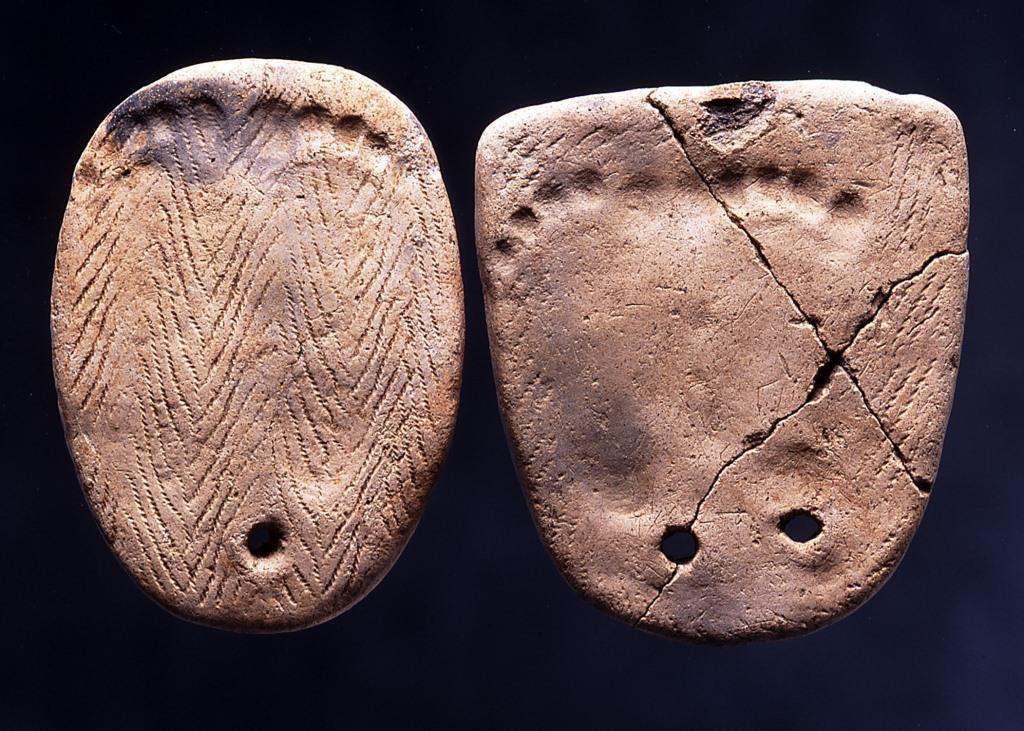
Burial pits at the Kakinoshima Site contained a range of burial goods, including clay tablets that display footprints. The tablets (5000–4500 BCE) differ in shape and size, but all are patterned with cord markings and bear the impression of a single foot or of two feet. The footprints measure between 6 and 18 centimeters, and are likely those of children. Some tablets also display handprints on the reverse side.
U-shaped earthwork

A large U-shaped earthwork remains visible at the site. It contains large quantities of pottery, stone tools, and the fragments of animal bones. Soil and some artifacts from parts of the earthwork show evidence of charring, suggesting fires may have been lit here. Archaeologists discovered a channel which they believe to be a path leading into the center of the U, dug into the ground at one of its corners. Within the center of the U, they found a small mound containing ritual tools such as stone rods and swords. Archaeologists believe offerings and ceremonies including funeral rites were held at the earthwork.
The earthwork dates from 3000 BCE and was likely constructed over many centuries. It measures more than 190 meters in length and is 120-meters wide. The embankments reach 2 meters at their tallest points.
Pottery artifacts
A great range of pottery has been discovered at the Kakinoshima Site. The earliest examples are vessels with pointed bottoms, patterned by pressing shells into the clay. Later items include an ornately decorated and lacquered spouted vessel and an intricately crafted pot with multiple openings, shaped like an incense burner. The artifacts demonstrate a highly developed design sense and the mastery of advanced ceramic techniques.
The Hakodate Jomon Culture Center
The Hakodate Jomon Culture Center displays artifacts from the Kakinoshima Site, the Ofune Site (a ten-minute drive away), and other local archaeological sites. The most prized artifact is a hollow clay figurine (chuku dogu) that was discovered by a lady tending her vegetable garden. The figurine is praised by archaeologists and art historians for its intricate design, burnished finish, detailed patterning, and excellent state of preservation. It is designated a National Treasure of Japan and has been exhibited at leading museums around the world including the Tokyo National Museum, British Museum, and the Smithsonian Institution.
In addition to the exhibits, the museum has a workshop where visitors can try weaving, pottery making, and other prehistoric-themed crafts. The museum charges a small admission fee. Information is provided in English.
Related archaeological sites
The Ofune Site is 10 minutes from the Kakinoshima Site by car. Evidence of a large-scale settlement has been found here, and visitors can view the foundations of large pit dwellings at the site. Other sites in Hokkaido include the Irie Site and the Kitakogane Site, where large shell mounds have been discovered, and the Kiusu Earthwork Burial Circles, near Sapporo.
(This English-language text was created by the Japan Tourism Agency.)
Kitakogane Site
The Kitakogane Site in Date, Hokkaido, dates from 5000 to 3500 BCE. Archaeologists have uncovered large shell mounds, several sets of human remains, and a range of artifacts that provide evidence of complex ritual practices. The site is on a hillside facing Uchiura Bay, a few hundred meters from the shore. At the entrance to the site, there is a museum with exhibits and multilingual information.
Findings from the shell mounds
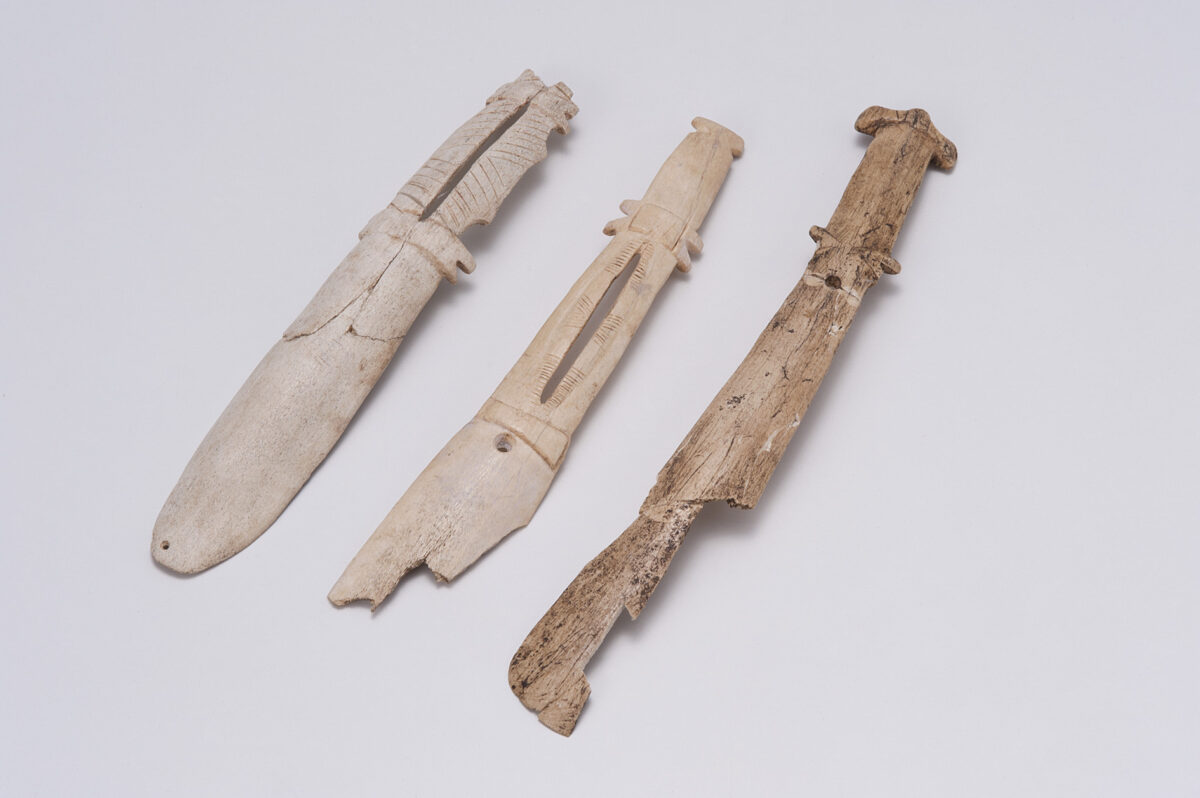
Five shell mounds have been discovered at the Kitakogane Site. They contain the shells of saltwater clams, oysters, and sea urchin, as well as the bones of fish, fur seals, whales, deer, and other animals. Discoveries of burial pits within and beneath the shell mounds suggest they were places of ritual significance. One of the mounds has yielded 14 sets of ceremoniously buried human remains and decorative spoons carved from whale bone and deer antler. In another mound, the skulls of deer were found arranged in an intentional pattern.
Shell mounds and the shoreline
Shell mounds were made close to the shore, so as the shoreline receded over time, the location of the shell mounds moved down the hillside. The oldest shell mound is the highest, while the others are located successively lower. Over the course of approximately 1,500 years, the climate cooled and the sea level fell, causing the shoreline to recede.
Diet and livelihood
Studies of the human remains suggest that the inhabitants of the Kitakogane Site consumed more fish than meat, and nuts in relatively modest quantities. The bones contain high levels of protein derived from fish and other marine life. Cavities are a sign of heavy nut consumption, but the teeth found at the site have no cavities.
It is likely that fishing was the main subsistence activity. Tools such as net sinkers made from stone and fishhooks and harpoon heads made from antler have been found across the site.
Ritual deposits of stone tools
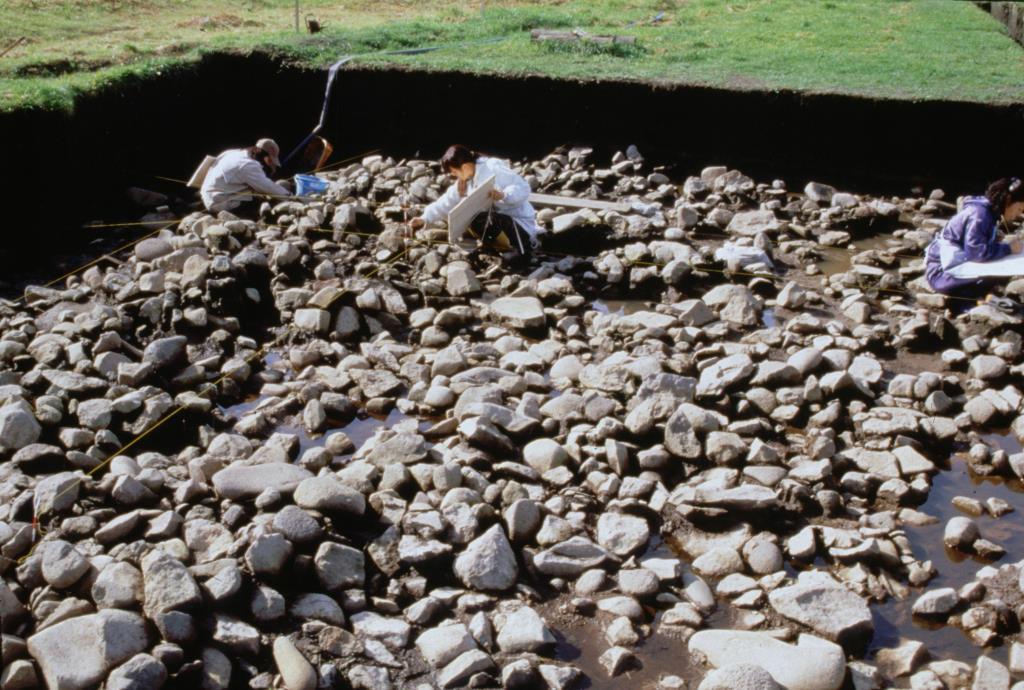
Vast quantities of stone tools have been discovered near a spring at the foot of the hillside. The area has been left as it was excavated, with stone tools such as grinding stones and milling basins clearly visible, embedded in the earth. Many of the items appear to have been intentionally broken or deliberately scraped and damaged. Archaeologists believe the items were discarded here in a ritual manner that had symbolic meaning to the inhabitants of the site. It is not known why the tools were discarded in this way, but some archaeologists surmise that it may have been an expression of gratitude, possibly to the tools themselves, or to the water which supported life at the settlement.
Kitakogane Site Information Center
The Kitakogane Site Information Center exhibits artifacts from the site and displays an actual cross section from one of the shell mounds. Signs in English and Japanese indicate the types of bones and shells visible in the cross section. Artifacts displayed at the center include decorative items carved from antler and bone, hunting tools such as stone arrowheads and harpoon heads made from antler, as well as grinding stones including saddle quern milling stones. The grinding stones are displayed in a hands-on area and can be picked up and examined freely. The museum is free of charge.
Related archaeological sites
The Irie Site and the Takasago Burial Site are 30 minutes from the Kitakogane Site by car. Shell mounds have been found at both of these sites. The Ofune Site and the Kakinoshima Site are large sites on the opposite side of Uchiura Bay. The Hakodate Jomon Culture Center displays artifacts from these two sites and gives a comprehensive overview of prehistoric life in northern Japan.
(This English-language text was created by the Japan Tourism Agency.)
Tagoyano Site
The Tagoyano Site in Aomori is located a few kilometers inland from the Sea of Japan, on a plateau overlooking the Tsugaru Plain. Potsherds and human remains discovered here date the site from 4000 to 2000 BCE. Archaeological surveys have revealed shell mounds, shell bracelets, tools crafted from the bones of whales, and the sites of pit dwellings.
Shell mounds
Shell mounds are typically constructed of the discarded shells of clams and the bones of animals. They are commonly found close to the coast at sites that would have bordered the shore. Shell mounds provide insight into the diet and means of livelihood of prehistoric people and indicate how coastal environments have changed over the last 10,000 years.
Findings from shell mounds at the Tagoyano Site
The mounds at the Tagoyano Site are made up almost exclusively of the shells of Japanese basket clams (Jp. yamato shijimi; Corbicula japonica). This indicates that these clams were an important food source for the people that inhabited the site. Japanese basket clams live in brackish-water habitats, so their presence shows that the Tagoyano Site would have bordered a coastal lagoon when it was inhabited. It is likely that Lake Jusanko, a coastal lagoon several kilometers away, once stretched as far south as the Tagoyano Site.
Human remains
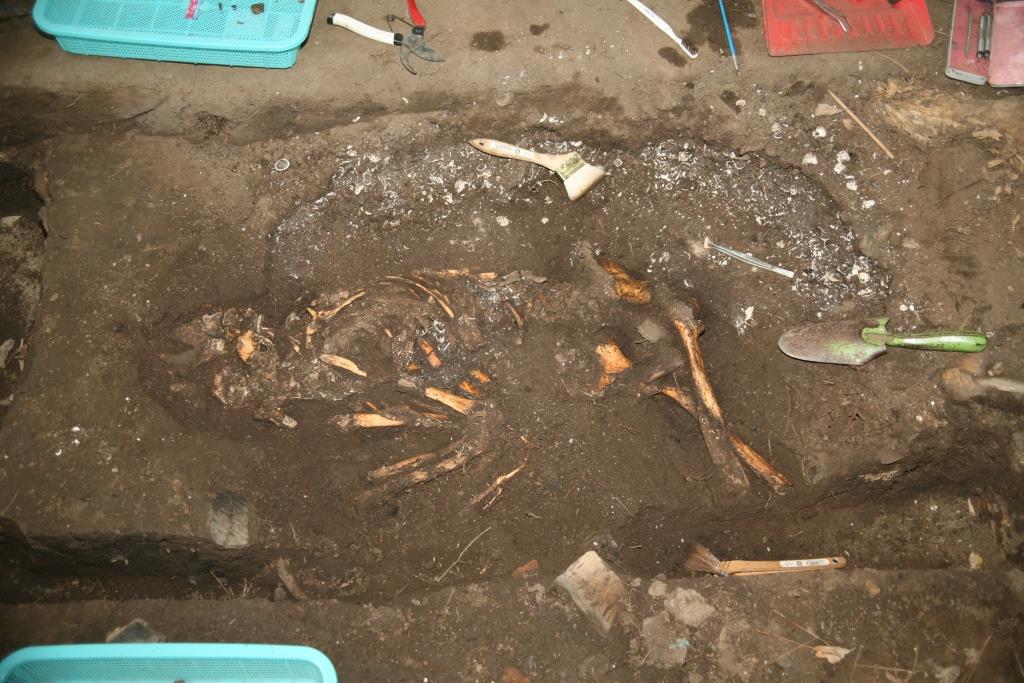
A set of human remains was found buried within a stratum of shell on the site of a pit dwelling at the Tagoyano Site. Investigation revealed the bones to be the remains of an adult female. Carbon dating suggests the woman lived around 6,000 years ago.
Bracelets and trade
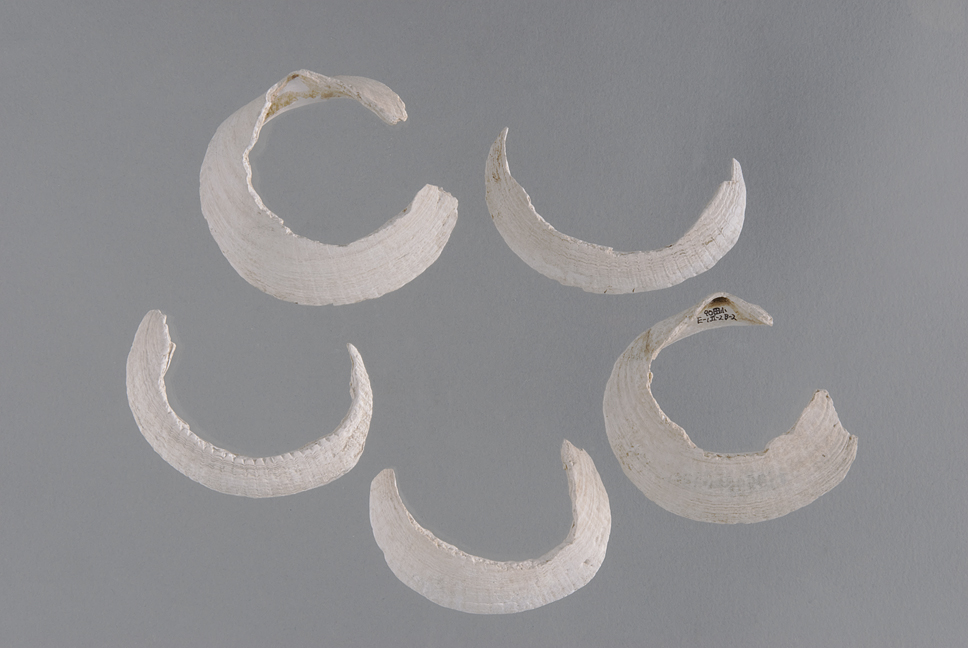
Among the artifacts discovered at the Tagoyano Site are bangle-like bracelets made from clam shells found along the western shore of the Tsugaru Peninsula. Unworked shells and bracelets in various stages of production have been discovered at the Tagoyano Site, indicating that the bracelets were produced there. It is likely that the inhabitants of the Tagoyano Site traded their bracelets with communities in southern Hokkaido. Several finished bracelets have been unearthed at archaeological sites there, and obsidian tools from Hokkaido have been found at the Tagoyano Site.
Artifacts and related archaeological sites
Artifacts from the Tagoyano Site are on display at the Tsugaru City Jomon Dwelling Museum and the Tsugaru City Kizukuri Kamegaoka Archaeological Museum. Artifacts from the Kamegaoka Burial Site and other nearby sites are also exhibited. The Kamegaoka Burial Site can be reached on foot in five minutes from the Tagoyano Site. Other sites in Aomori include the Sannai Maruyama Site, the Komakino Stone Circle, and the Odai Yamamoto Site.
(This English-language text was created by the Japan Tourism Agency.)
Futatsumori Site
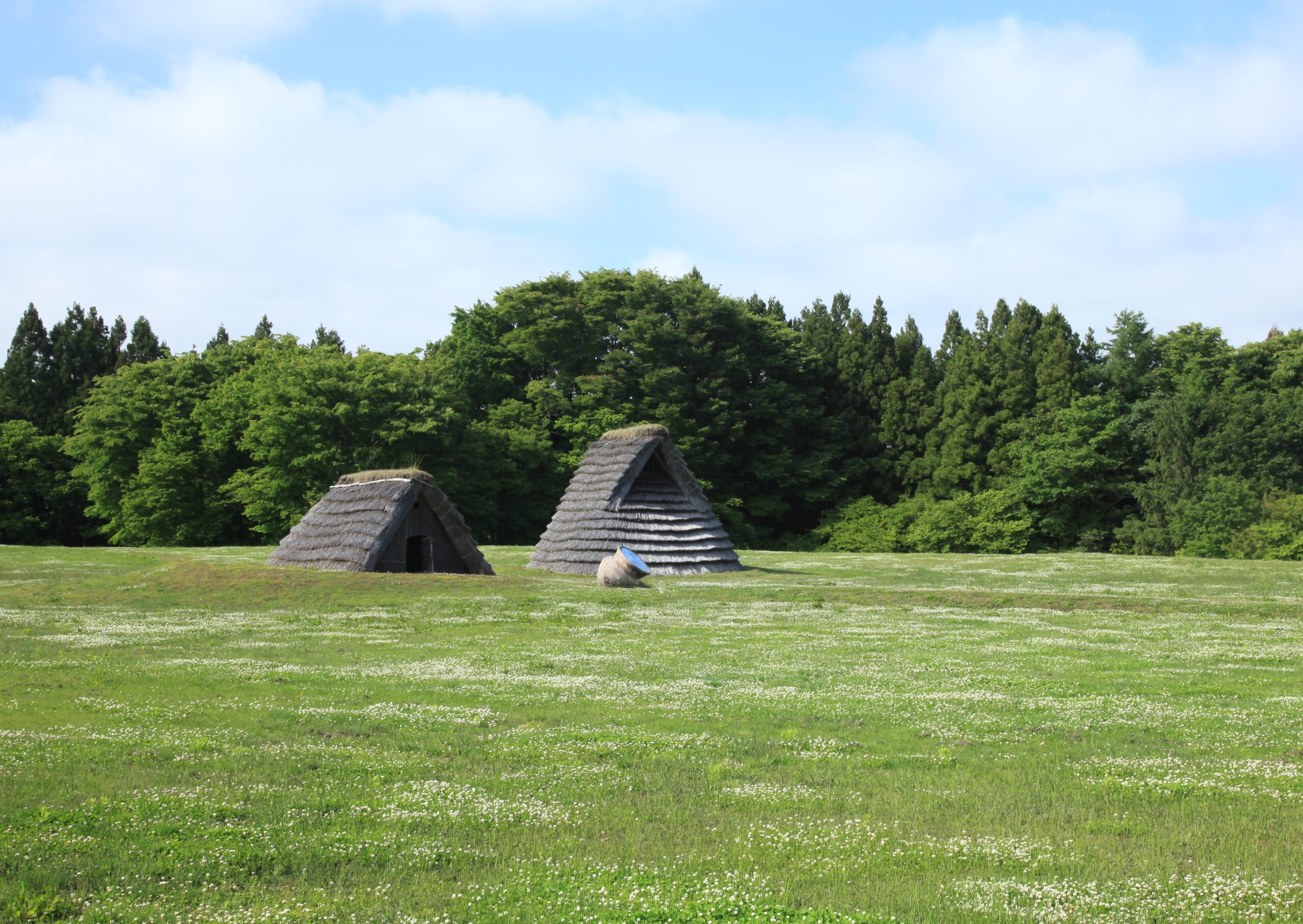
Several settlements existed between 3500 and 2000 BCE at the Futatsumori Site, a few kilometers west of Lake Ogawara in Aomori. Evidence of nearly 150 pit dwellings and several shell mounds have been discovered throughout the site. Models of two pit dwellings have been constructed at the site, and artifacts including adornments made from deer antler are displayed nearby, at the Futatsumori Site Museum.
Size and layout of the settlements
An observation deck near the parking lot gives an elevated view across the site, and an illustrated map depicts the layout of one of the settlements. The settlements at the Futatsumori Site were large and included graveyards, pits for storing foraged foods, and shell mounds, as well as areas for discarding pottery, stone tools, and other items.
Evidence of environmental changes
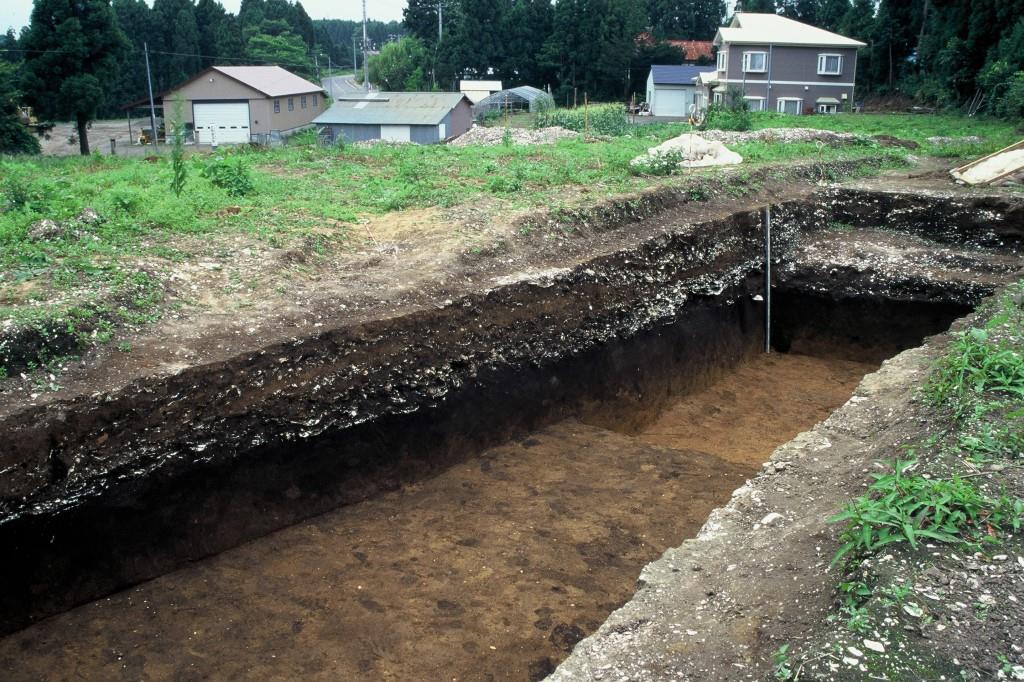
Circa 3900 BCE, the Futatsumori Site would have overlooked a large bay. Over the centuries, sea levels dropped, the shoreline receded, and the bay became Lake Ogawara, a brackish body of water. These environmental changes can be observed in the type and distribution of shells within the shell mounds. Lower layers contain the shells of oysters, common Orient clams, and other ocean-dwelling shellfish, whereas upper layers contain the shells of brackish-water species, such as Japanese basket clams.
Subsistence activities
The shell mounds also contain the bones of fish, swans, ducks, deer, and boars, indicating the inhabitants of the settlements here hunted and fished as well as gathered shellfish. The presence of storage pits, typically used for storing chestnuts, suggests they also foraged in the forests.
Related archaeological sites
Other settlement sites discovered in northern Japan include the Sannai Maruyama Site (Aomori), Goshono Site (Iwate), and the Ofune Site (Hokkaido).
(This English-language text was created by the Japan Tourism Agency.)
Sannai Maruyama Site
Traces of pit dwellings, foundations of large structures, mounds containing large quantities of earthenware, burial areas, and clay mining pits for pottery production tell much about prehistoric life and society at Aomori’s Sannai Maruyama Site. The site is one of the largest settlement sites of the Jomon period (13,000–400 BCE) discovered to date, and archaeological surveys indicate that a sizeable settlement existed here for over a thousand years between 3900 and 2200 BCE.
Development of settlements
Food sources and environmental factors led to changes in the scale and form of settlements over the course of the Jomon period (13,000–400 BCE). They began at the end of the last glacial period as seasonal bases for foraging and hunting. As temperatures rose and food became more abundant, settlements became more permanent. They grew considerably in size between 5000 and 2000 BCE, with large ones like that at Sannai Maruyama emerging around 3000 BCE. From 2000 to 400 BCE, the climate cooled and settlements became smaller.
Pit dwellings large and small
The population of the Sannai Maruyama settlement is difficult to estimate, but surveys of the site suggest it could have reached several hundred. The foundations of more than 500 pit dwellings have been identified to date, including those of “dwellings” that measured up to 32 meters in length. A number of these pit dwellings have been recreated and are open for visitors to enter. Archaeologists believe the larger dwellings may have functioned as community spaces, workshops, or communal winter living spaces.
Burial areas
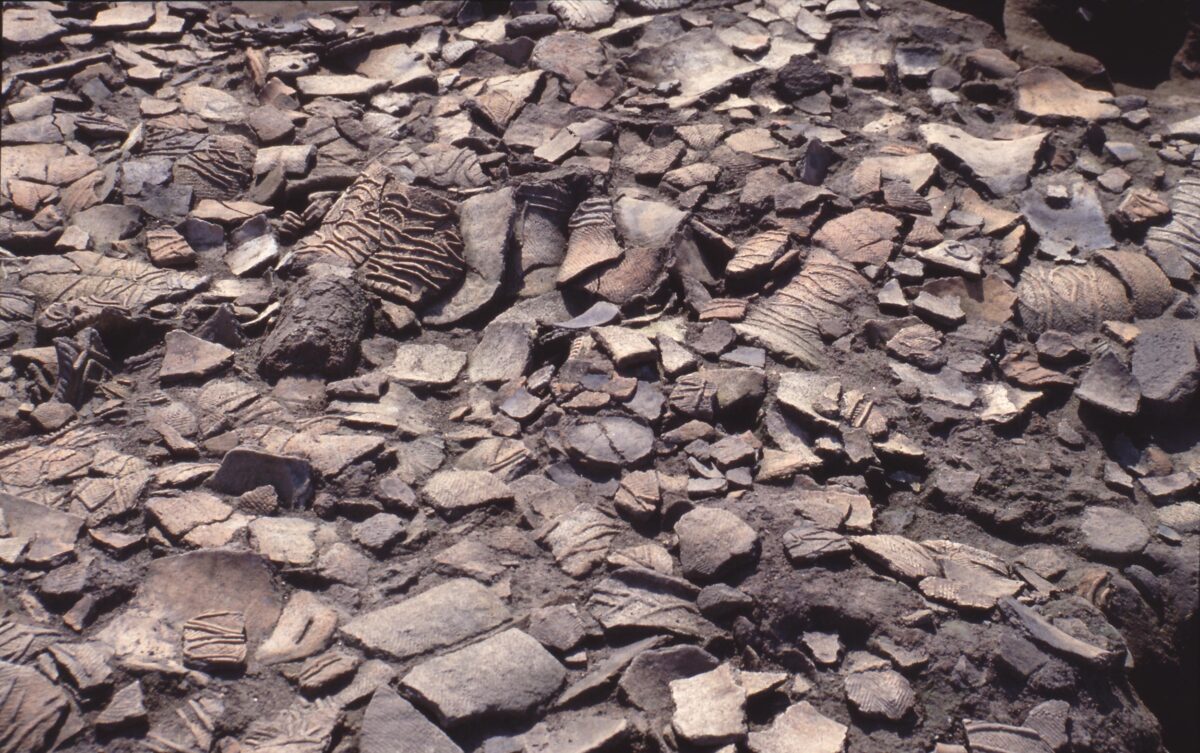
Burial areas, surveys show, appear to have been separate for adults and children. Some 500 burial pits have been found lining certain paths running through the settlement. The size of the pits indicates that these would have been for adults. Infants and younger children were interred in burial jars. More than 500 of these vessels have been found buried near the North Mound, one of three artificial mounds containing large quantities of potsherds.
Trade and crafts
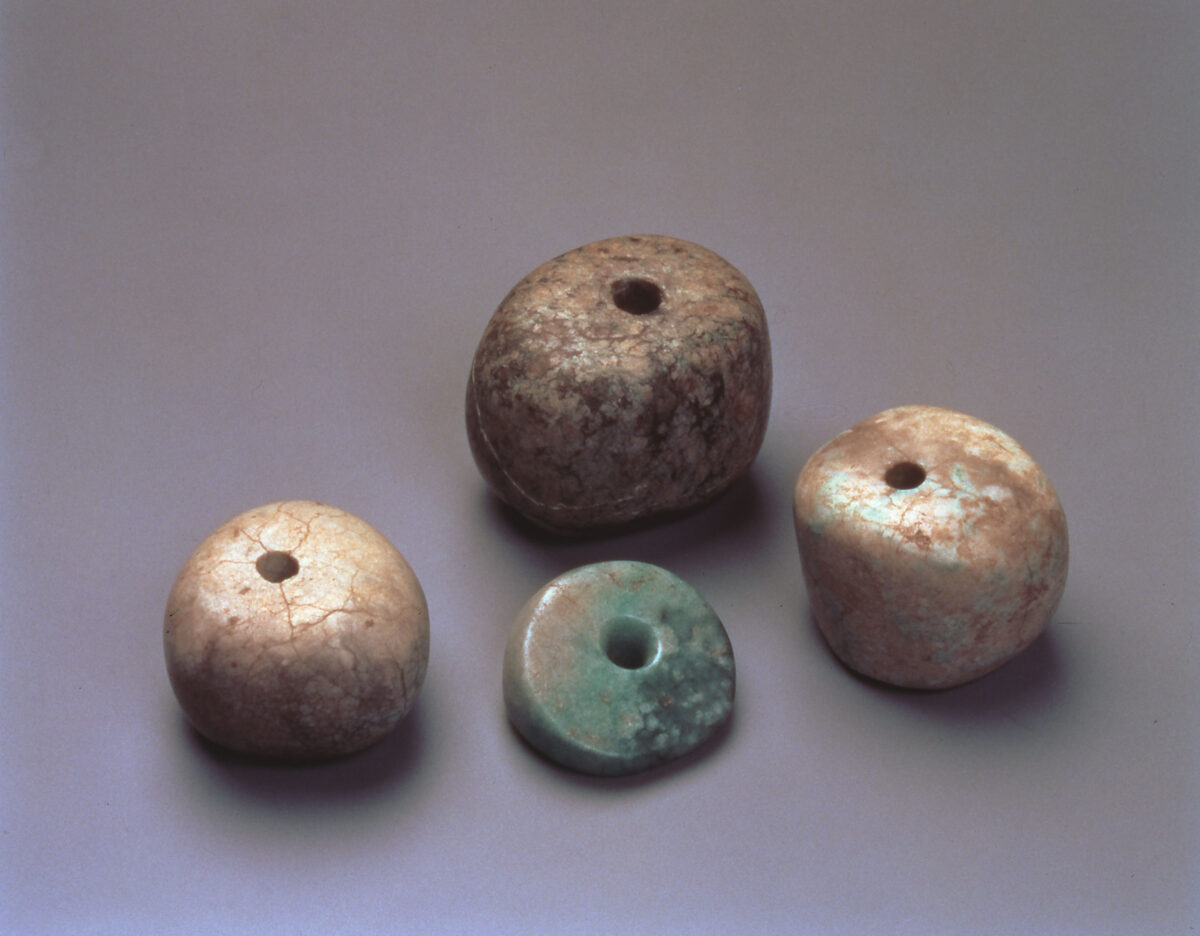
Artifacts uncovered at the Sannai Maruyama Site indicate trade with other regions of Japan. Items made of jade, amber, and obsidian, and tools glued using asphalt are among them. The materials to make such items would not have been available locally, and would have originated as far away as 500 kilometers. Jade beads, amber accessories, and obsidian spearheads, as well as unworked raw materials and incomplete items, have been unearthed. Such discoveries imply the presence of craftspeople with the skills to work these materials.
Sannai Maruyama Jomon Culture Center
Entrance to the archaeological site is through the Sannai Maruyama Jomon Culture Center, a museum with exhibits introducing life at the settlement through artifacts found there. Tickets to the museum allow access to the archaeological site. The museum features the Jomon Big Wall, a 6-meter-high wall embedded with more than 5000 potsherds; Jomon-themed workshops such as clay figurine making; and a viewing gallery where visitors can see archaeologists at work in restoring earthenware vessels. There is a gift shop and cafeteria on-site. Information is provided in English throughout the museum and its facilities.
Related archaeological sites
Several of the Jomon Prehistoric Sites in Northern Japan are located in Aomori Prefecture. The Komakino Stone Circle is in Aomori City, only a few kilometers from the Sannai Maruyama Site. The Korekawa Site in Hachinohe has a museum exhibiting highly refined pottery and lacquerware from the final centuries of the Jomon period.
(This English-language text was created by the Japan Tourism Agency.)
Ofune Site
Evidence of a large-scale settlement (c. 3200 BCE) has been uncovered at the Ofune Site in Hakodate, southern Hokkaido. Archaeological excavations have revealed the foundations of more than 100 pit dwellings, graves, storage pits, and an earthwork mound containing large quantities of pottery, stone tools, and animal bones. Findings indicate the site was settled continuously for almost 1,000 years.
A favorable location
The Ofune Site is located on a plateau that extends along the Ofune River and faces the Pacific Ocean. Carbonized chestnuts and the bones of fur seals, tuna, salmon, whales, and deer have been found at the site. Communities here would have fished the ocean, hunted along the coastline, and foraged in the forests.
Pit dwellings at the Ofune Site
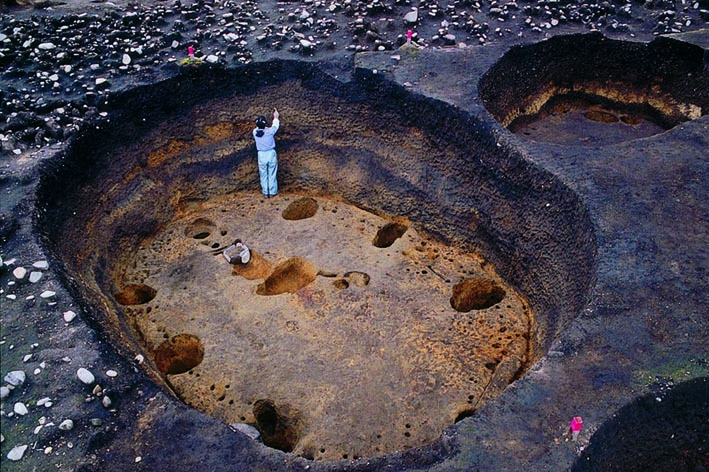
The inhabitants of the site lived in pit dwellings. These were wooden pillar-supported structures that enclosed a single living space dug into the ground. Archaeologists are able to identify the outlines of the pits and the post holes that held the pillars. The foundations of nearly 120 pit dwellings have been discovered at the Ofune Site. Many overlap, indicating that new dwellings were built on the sites of older dwellings.
Some of the pits discovered at the site measure more than 2-meters deep and nearly 10-meters long. Pits at most other sites are typically not as deep nor as long. Some of the largest foundations have been preserved in their excavated state to give visitors a sense of the scale of the dwellings that were constructed here.
An unusual discovery
Beneath the ground of one of the dwellings, archaeologists found a small hole with blackened soil at its base. Analysis of the soil revealed biological material possibly from the placenta. Archaeologists surmise that the act of burying the placenta had some ritual significance. In Japanese culture, it was once customary to bury the placenta within the entranceway to the home, to ensure the healthy growth of a newborn baby.
A treasure trove of artifacts

A large earthwork mound almost 80-meters long and 10-meters wide has been discovered at the site. It has yielded large quantities of pottery, stone tools, animal bones, and artifacts such as sewing needles made from deer antler. Pit graves have been found within the mound and there is evidence that fires were lit here. The mound seems to have functioned as a ritual space as well as an area to deposit tools.
Pottery: design and characteristics
Pottery artifacts from the Ofune Site indicate that the site was settled continuously for nearly a millennium. The pottery unearthed here is flat-bottomed and cylindrical in shape, with notable variations in patterning and design. The shape and design of pottery artifacts enable archaeologists to date Japan’s prehistoric sites and understand how long sites were settled. A clear change can be observed in the design of the artifacts unearthed at the Ofune Site, indicating it was settled for a long time. Earlier vessels have less elaborate decorative features and simple rims, whereas later pieces feature stylized rims and applique decorations.
Hakodate Jomon Culture Center
Artifacts from the Ofune Site are on display at the Hakodate Jomon Culture Center next to the Kakinoshima Site . The museum exhibits artifacts from several local archaeological sites, including a hollow clay figurine (chuku dogu) that is a National Treasure of Japan. The museum is a five-minute drive from the Ofune Site.
Related archaeological sites
Other large-scale settlements have been discovered at the Sannai Maruyama Site (Aomori), one of the largest Jomon archaeological sites in Japan, and the Goshono Site (Iwate).
(This English-language text was created by the Japan Tourism Agency.)
Goshono Site
The Goshono Site in northern Iwate was the location of a large-scale settlement dating from around 2500 BCE. Archaeologists have discovered the sites of more than 800 pit dwellings throughout the archaeological site, which now features walking trails and a museum.
Large-scale settlements

Goshono Site is important for understanding the layout of large-scale Jomon settlements. Such settlements were common between 3000 and 2000 BCE. They included several areas with specific functions arranged around a central burial area.
Archaeological surveys of the Goshono Site indicate that pit dwellings were concentrated in the eastern, central, and western parts of the settlement. At the center of the site, there is a cemetery marked with several stone arrangements. Adjacent to the cemetery is an artificial, earthern mound from which large quantities of ornamental earthenware and stone objects have been retrieved. The decorative nature of the artifacts implies that the area around the mound had a ritual significance and it is likely that ceremonies were performed here.
The natural environment
The archaeological site is on a large plateau, surrounded by forest. The entrance to the site is across a covered suspension bridge that curves across a narrow valley with a meandering stream. The grounds are planted with trees such as walnut, chestnut, horse chestnut, and lacquer trees, which would have grown at the site when it was settled. Trails lead around the site and information boards explain how the plants would have been used. Sap from the lacquer tree was extracted and refined to produce lacquer, which was used to decorate earthenware. Nut trees provided sustenance, timber for building, and firewood.
Pit dwellings
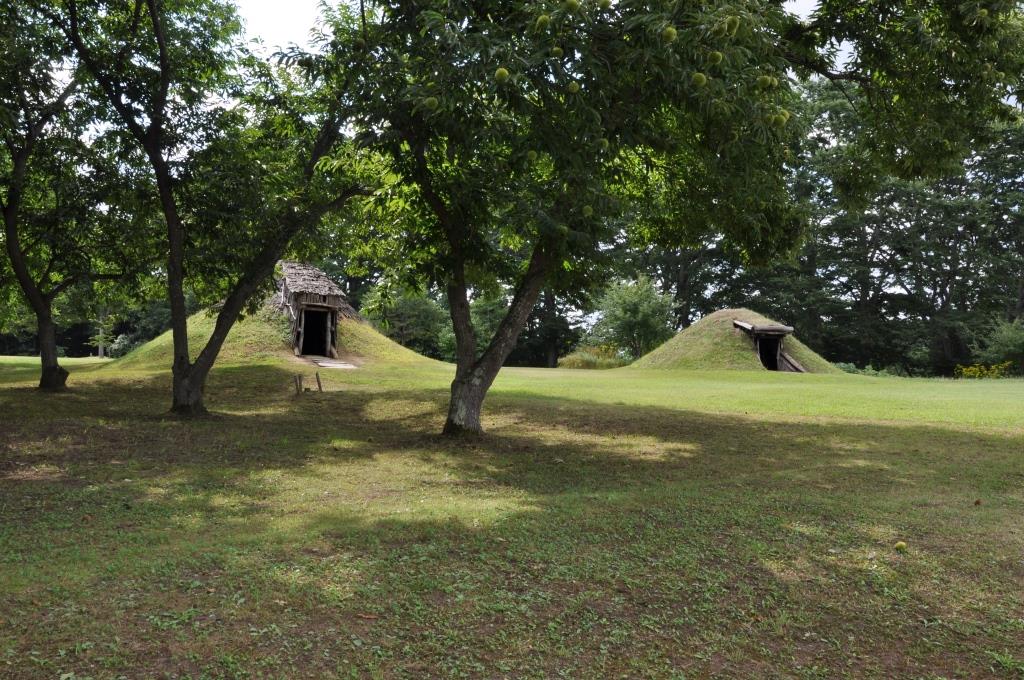
Several pit dwellings have been recreated at the site. Pit dwellings are commonly thought to have had thatched roofs, but investigations of the burnt remains of dwellings at the Goshono Site suggest some here, had roofs made from packed earth.
Pit dwellings from the Jomon period (13,000–400 BCE) vary in size but are generally supported by four or six structural pillars inserted directly into the ground of an oval-shaped pit. Their eaves stretch all the way to the upper edges of the pits, creating a well-sheltered bunker-like dwelling. Their interiors have a hearth, and some dwellings may also have had an attic-like space for storage.
Goshono Jomon Museum
The Goshono Jomon Museum exhibits artifacts from the Goshono Site and other nearby Jomon sites. The “Discovery of Burnt Buildings” exhibition details excavation work and investigations into the structure of Jomon pit dwellings at the Goshono Site. The burned remains of a 4200-year-old pit dwelling are visible beneath a glass floor in the exhibition hall. The Goshono Jomon World exhibition displays excavated pottery and stone tools, and uses projection mapping to introduce prehistoric life at the Goshono settlement. A third exhibition on the second floor introduces highly decorative “Kamegaoka style” pottery.
The museum provides information in English and offers Jomon-themed workshops on weaving and making pottery and jewelry. The museum charges a small fee for admission.
Related archaeological sites
Other settlements from a similar period have been discovered at the Sannai Maruyama Site (Aomori), one of the largest Jomon archaeological sites in Japan, and the Ofune Site (Hokkaido).
(This English-language text was created by the Japan Tourism Agency.)
Irie Site
The Irie Site is a coastal site with large mounds made up of discarded shells and the bones of fish and animals. These shell mounds at the Irie Site were likely formed over several centuries with the top layers of the mounds dating from approximately 2000 BCE. Numerous graves and the sites of pit dwellings have also been discovered.
The archaeological site is open to the public. Displays include a large preserved cross section of earth, shells, and bones taken from one of the mounds and a three-dimensional representation of a pit dwelling. The site is within walking distance of the Takasago Burial Site and the Irie Takasago Museum.
The sea and shell mounds
As the climate grew warmer (8000–5000 BCE), sea levels rose, and prime hunting and foraging areas were replaced by shallow bays and fishing and shellfish gathering methods began to develop. Prehistoric communities of northern Japan relied increasingly on these activities for sustenance and consumed large quantities of seafood. As a result, shell mounds formed next to the settlements.
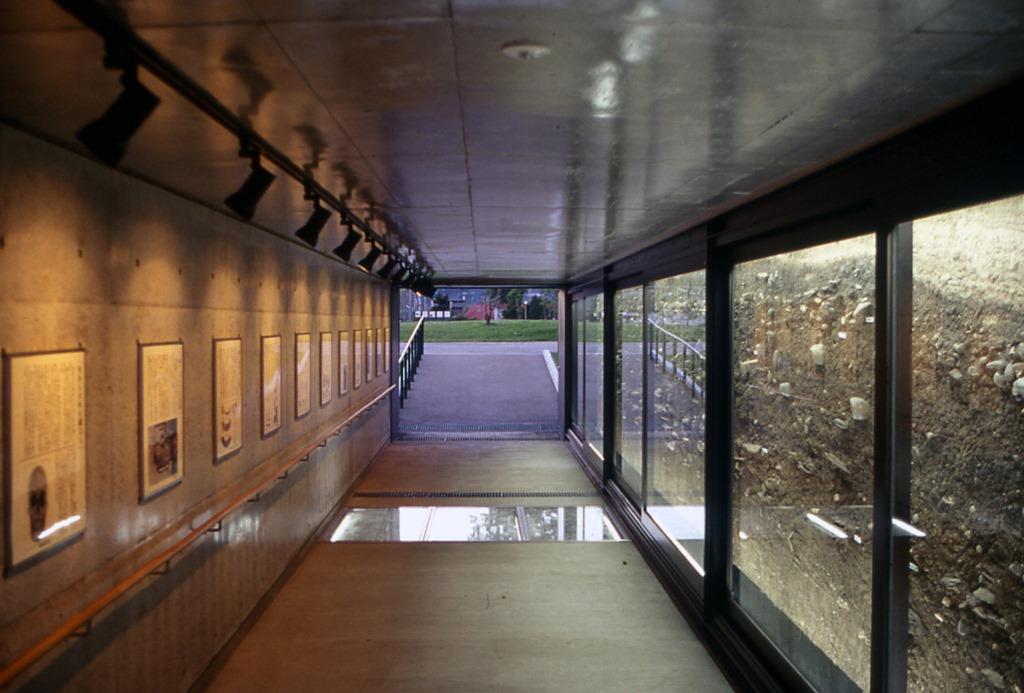
Shell mounds allow archaeologists to study how diets changed over time and in response to environmental factors. The shells of Asian hard clams (Meretrix lusoria) and oysters in lower layers and Japanese cockle (Venerupis philippinarum) shells in higher layers indicate a change in water temperature and sea levels. At the Irie Site, inhabitants of the settlement relied on both fishing and hunting for sustenance, typically consuming more meat and fish than shellfish.
At the entrance to the park, there is a large cross section of one of the shell mounds. It is several meters high and long, and bones and shells are visible in varying quantities. Bones, which include those of fur seals, dolphins, deer, and other fish and animals, feature more prominently than shells.
Fishing implements and trade
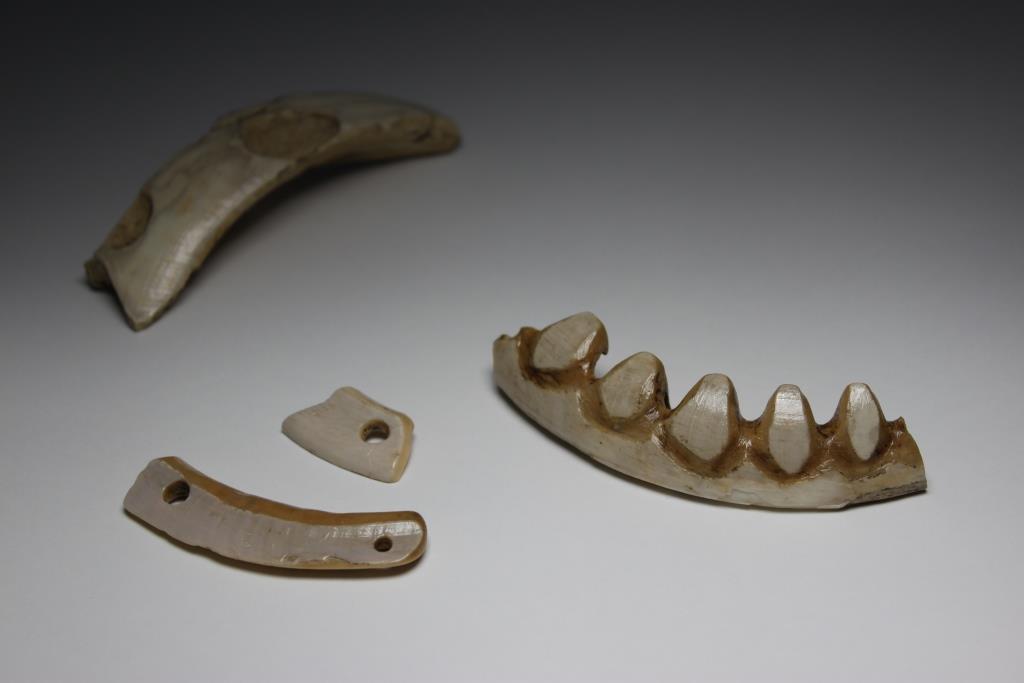
A wide variety of fishhooks unearthed at the Irie Site show how fishing implements developed, and larger combination hooks indicate that open-sea fishing was common. Items made with materials not indigenous to Hokkaido, such as boar-tusk ornaments, have been found at the site. These are thought to be evidence of maritime trade with communities on Japan’s main island of Honshu.
Artifacts from the site are displayed at the Irie Takasago Museum. An entrance fee is required. Some basic information is in English.
(This English-language text was created by the Japan Tourism Agency.)
Komakino Stone Circle
Thousands of stones are arranged in concentric circles on a purposefully leveled plateau at the Komakino Stone Circle site in Aomori. Three complete rings and a partial fourth ring form a stone circle 55 meters in diameter. The stone circle dates from around 2000 BCE and is one of several large prehistoric monuments in northern Japan. Archaeological surveys have revealed burial pits, the sites of pit dwellings, and deposits of ritual items.
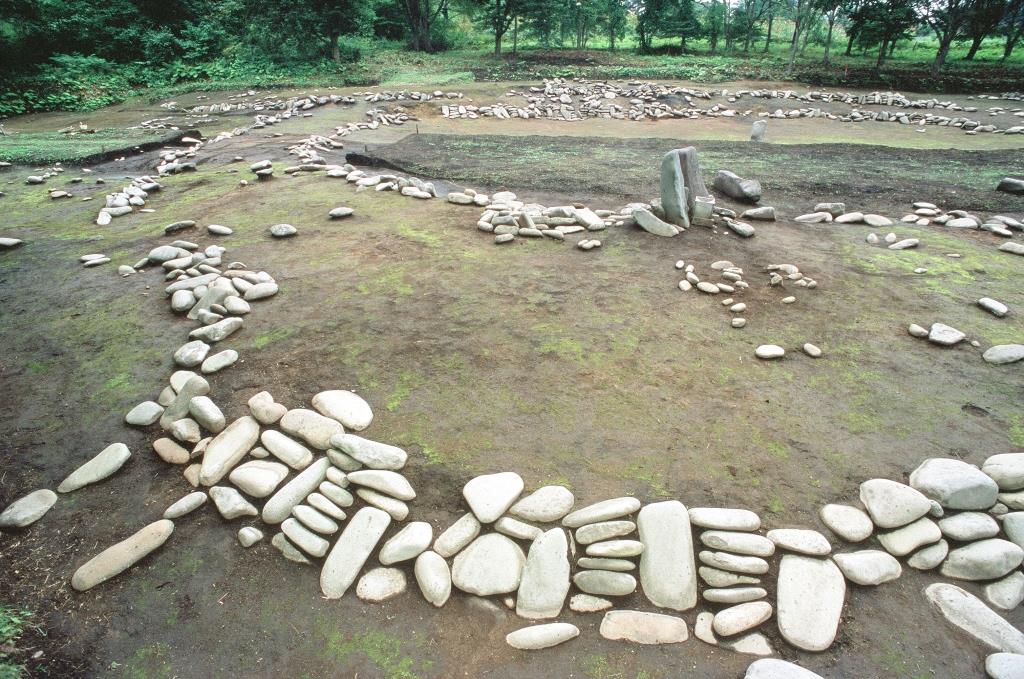
The stone circle can be viewed close up from multiple points. There is a path leading into the center for close inspection of the stones and their arrangement, and a mound to the south for viewing it from above. Close to the Komakino Stone Circle Conservation Center, at the entrance to the archaeological site, there is a lookout with views of Mutsu Bay, the Aomori Plain, and the western foothills of Mt. Hakkoda.
Komakino Site Preservation Museum
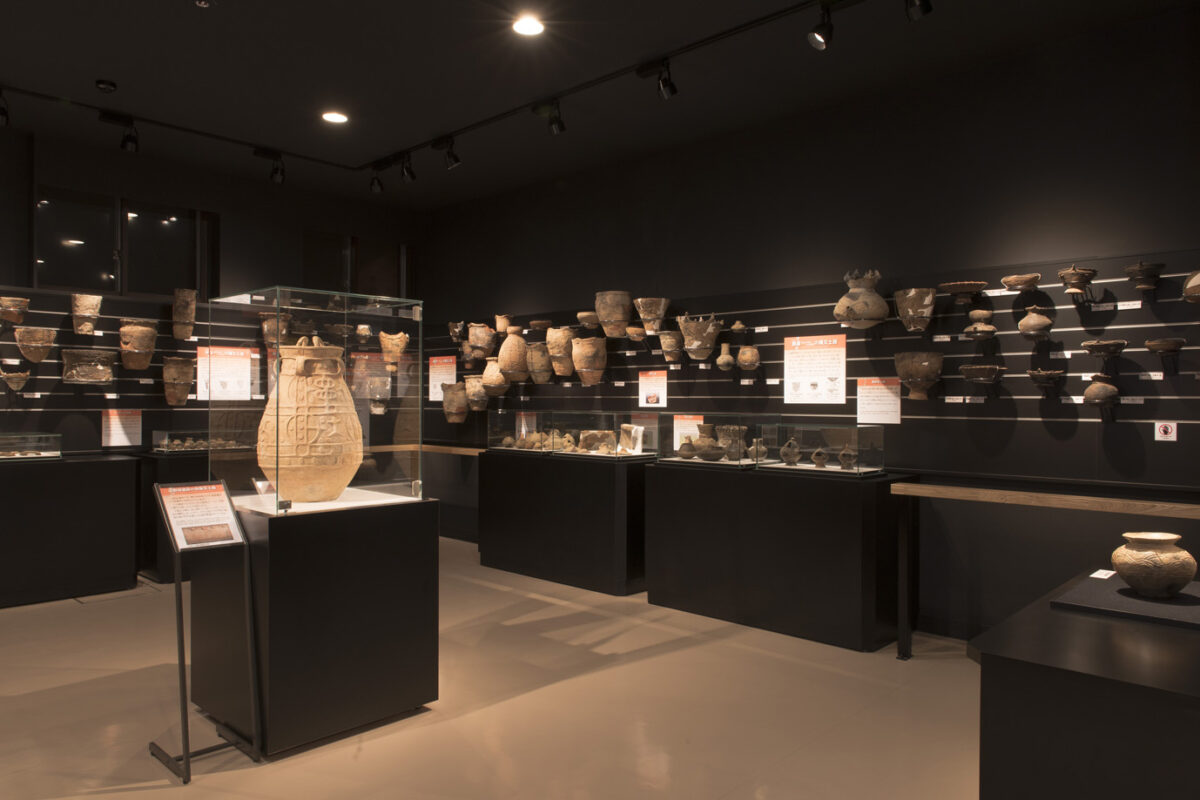
Information about the Komakino Stone Circle is available at the Komakino Stone Circle Preservation Museum, 1.5 kilometers from the archaeological site. Exhibits give an overview of life in the Jomon period and introduce some of the artifacts unearthed at the Komakino Site. Exhibits provide information in English and include hands-on elements for younger visitors. Entrance is free.
Related archaeological sites
Other large prehistoric monuments in northern Japan include the stone circles of Omori Katsuyama (Aomori), Isedotai (Akita), Oyu (Akita), and Washinoki (Hokkaido).
(This English-language text was created by the Japan Tourism Agency.)
Isedotai Stone Circles
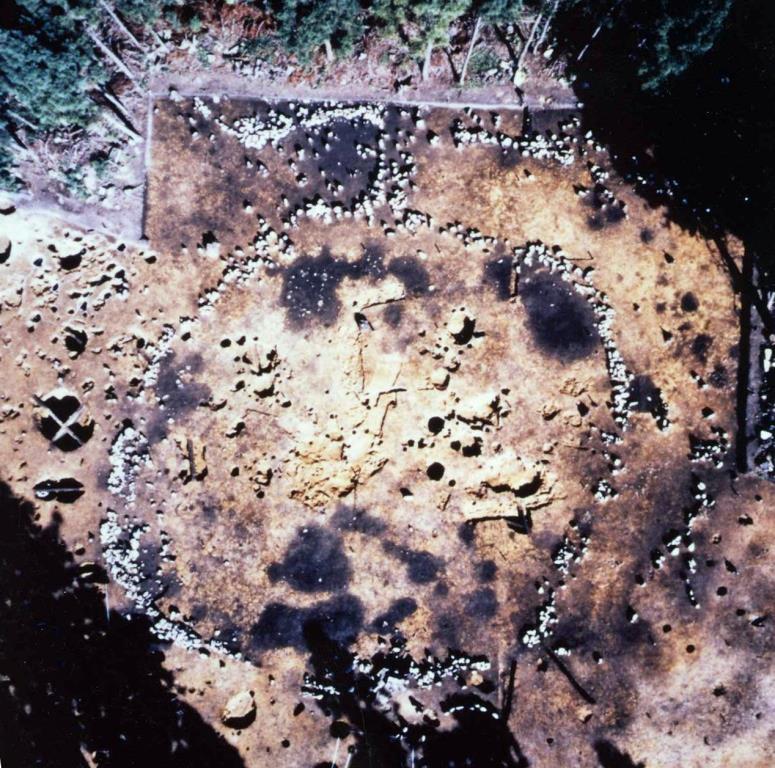
More than 4,000 stones are arranged in four circles (c. 2000 BCE) at the Isedotai archaeological site in northern Akita. Evidence suggests the circles were constructed over 200 years and served as ritual spaces. Large quantities of pottery have been found buried around the circles, including clay figurines (dogu) in a broad range of styles and designs.
Sourcing the stones
The circles are located on a plateau with views of the Shirakami Sanchi mountain range. They are made up of many types of stones, sourced from local rivers such as the Yoneshiro and Osarube. Archaeologists believe the stones may have been transported over distances of up to 5 kilometers.
Preparing the site
Surveys of the circles indicate that the ground was worked before the stones were set in position. Leveling and digging work would have been carried out with simple tools made only of stone or wood.
Buildings around the stone circles
Around the outer edges of the circles, the remains of pillar-supported structures have been found. It is unclear what the structures were used for, but they are not believed to be dwellings. Findings indicate it was a ritual site, likely shared by communities in the surrounding area.
Some theories suggest the structures may have been used for laying out and preparing the deceased for burial. Consistent with this theory, burial pits have been found around the circles. The graves have not yielded any human remains because of the acidity of the soil, but many have contained clay figurines and burial items. Post holes have been left uncovered around some of the circles and pillars have been erected to give visitors a sense of the scale of the structures.
Clay figurines
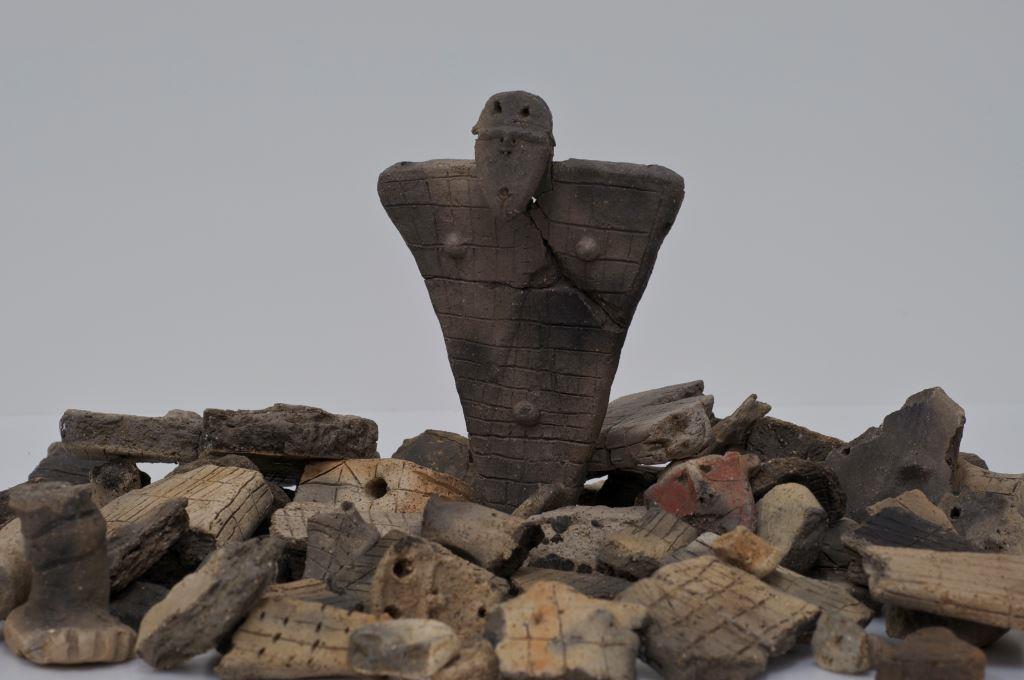
More than 200 clay figurines (dogu) in human form and with distinct and expressive facial expressions, have been found at the Isedotai site. They range in style and design from flat, tablet-like figurines (banjo dogu) to hollow figures (chuku dogu). More simplistic designs have an abstract shape without clearly defined limbs, whereas more elaborate figurines feature detailed patterning, accentuated curves, and identifiable body parts. Many have been intentionally broken, in an act of ritual expression, possibly prayer.
Isedotai Jomon Museum
The Isedotai Jomon Museum at the entrance to the site displays unearthed artifacts in brightly lit showcases. The lighting highlights the facial expressions and intricacies of the clay figurines and other pottery works. Exhibits at the museum give an overview of the site and the stone circles. Large displays with photos of the excavation work, present the findings of archaeological investigations in English and Japanese.
The museum holds craft workshops, where visitors can make accessories and clay vessels. Reservations are required. There is a gift shop selling a range of t-shirts and clay-figurine-themed souvenirs. A small admission fee is required to enter the exhibition space, but the gift shop and museum foyer are free of charge. In the foyer, a short video about the stone circles is screened. The video is available in several different languages including English.
Related archaeological sites
Other large prehistoric monuments in northern Japan include the Kiusu Earthwork Burial Circles (Hokkaido) and the stone circles of Oyu (Akita), Washinoki (Hokkaido), Komakino (Aomori), and Omori Katsuyama (Aomori).
(This English-language text was created by the Japan Tourism Agency.)
Oyu Stone Circles
More than 8000 stones are arranged in two large circles at this archaeological site in Kazuno, Akita. The monuments date from around 2000 BCE and are positioned in a way that demonstrates an understanding of the sun’s movements. Constructing them would have required immense effort and careful planning. An on-site museum provides information about the stone circles and exhibits earthenware, ritual objects, and other artifacts uncovered at the site.
Characteristics of the stone circles
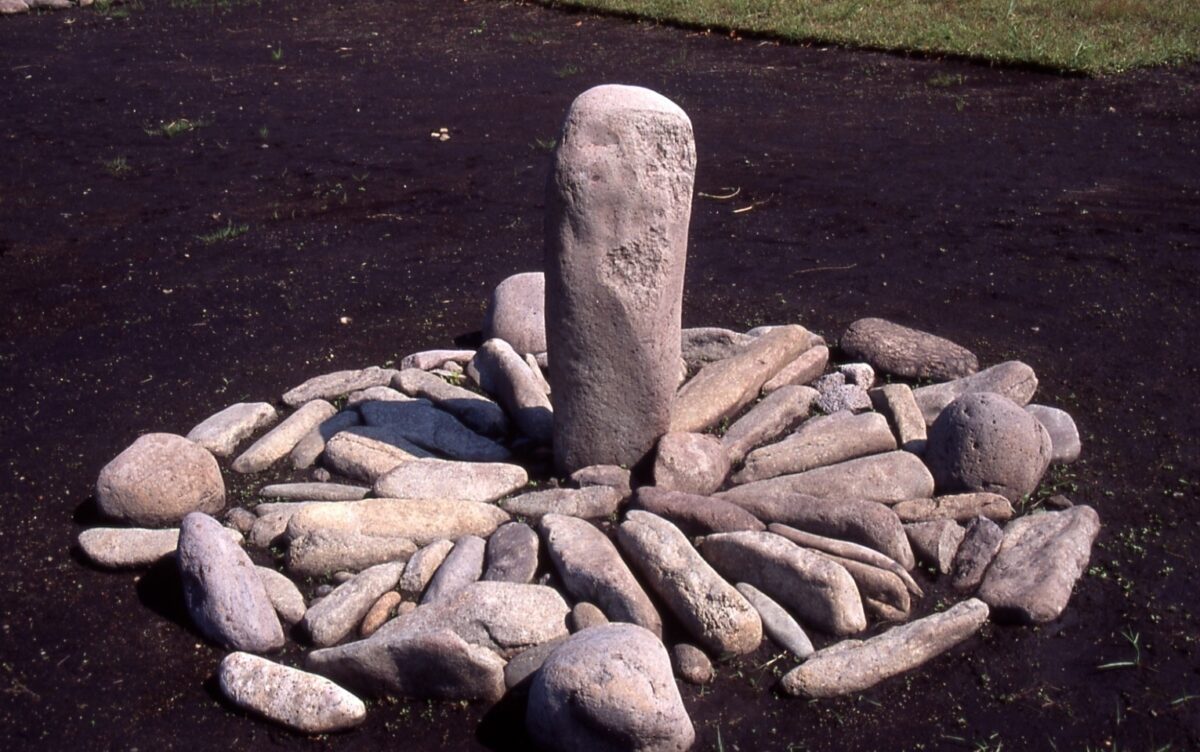
Both circles are made up of inner and outer rings of stones grouped together in small arrangements. Within the rings of each circle, there is a set of stones arranged in a radial pattern around a single standing stone. These radial arrangements resemble sundials, and during the summer and winter solstices, they cast shadows in a single line along a northwest-southeast axis. Archaeological surveys have revealed burial pits beneath the stone arrangements, and archaeologists believe each individual arrangement marks a grave.
Manza Stone Circle
At 52 meters in diameter, the Manza Stone Circle is the larger of the circles. Approximately 6500 stones were used in its construction, and more than 100 arrangements have been identified.
Nonakado Stone Circle
The Nonakado Stone Circle is located roughly 100 meters from the Manza circle. Approximately 2000 stones and more than 60 arrangements comprise the Nonakado Stone Circle, which measures 44 meters in diameter.
Archaeological findings
The foundations of four- and six-pillar structures were revealed around the outer rings of the stone circles together with deposits of objects thought to have been used in rituals. Due to the characteristics of the foundations and the large quantities of ritual items found nearby, archaeologists believe the structures had a ceremonial function and were not inhabited. Several structures built around the Manza Stone Circle give visitors an idea of how the circle might have looked 4000 years ago.
Construction of the stone circles
Archaeologists estimate construction of the stone circles took more than 200 years. The heaviest stones weigh more than 200 kilograms. They would have been transported from rivers up to 4 kilometers away using only simple implements.
Green stones
Many of the stones used in the Oyu circles have a greenish hue. They are a particular type of stone originating on Mt. Morosuke, several kilometers east of the circles. The stones would have made their way downstream from the Akuya River, which runs through the foothills of Mt. Morosuke, into the Oyu River, the river closest to the archaeological site. It is not known why these particular stones were favored in the construction of the circles, but they likely had a special significance.
Oyu Stone Circles Museum
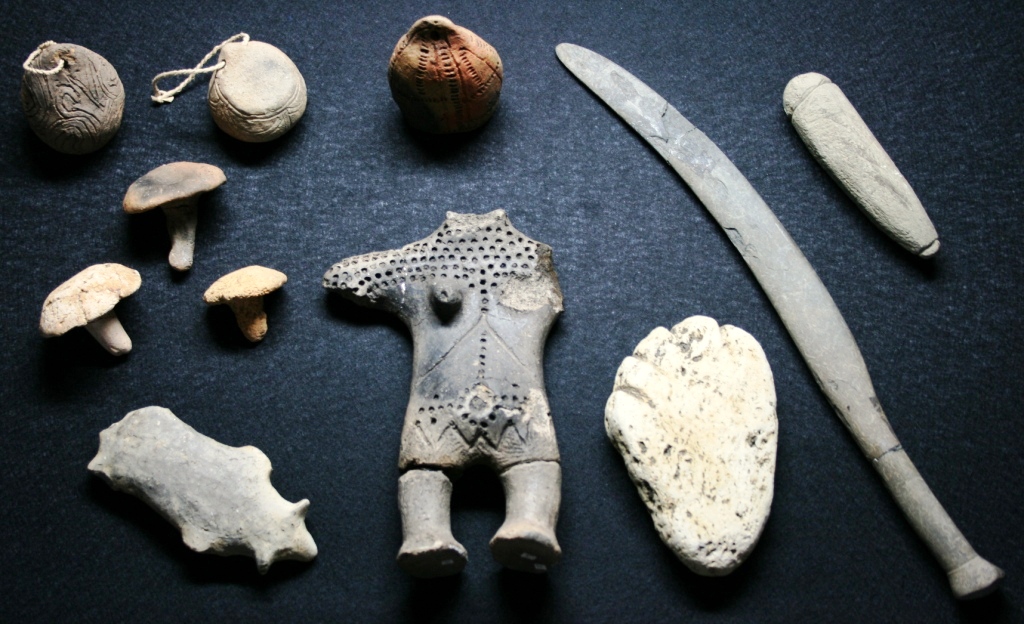
Hundreds of clay vessels (doki), clay figurines (dogu), clay tablets (doban), and stone objects unearthed through excavations are displayed at the Oyu Stone Circles Museum. The pottery works include large, urn-like vessels used to inter the remains of the deceased and elaborately decorated bowls and vases. The stone objects are mostly small and fashioned into shapes such as swords, bowls, and flat, triangular plates. Everything excavated is ornamental and believed to have served a ceremonial purpose.
Related archaeological sites
Other large prehistoric monuments in northern Japan include the stone circles of Isedotai (Akita), Washinoki (Hokkaido), Komakino (Aomori), and Omori Katsuyama (Aomori).
(This English-language text was created by the Japan Tourism Agency.)
Kiusu Earthwork Burial Circles
The Kiusu Earthwork Burial Circles (c. 1200 BCE) date from the latter part of the Jomon period (13,000–400 BCE) and are located in forestland outside the town of Chitose, southeast of Sapporo. They range in size from 30 to 75 meters in diameter and are arranged in a manner suggesting significant planning. The earthworks attest to complex burial practices in the settled communities of prehistoric northern Japan.
A path leads through the site, around the earthwork circles and along some of their embankments. Artifacts excavated from the burial circles and other nearby archaeological sites are displayed at the Chitose City Buried Cultural Properties Center.
Large-scale earthworks

In certain parts of Hokkaido, particularly here where the Kiusu circles are located, large circular areas of land were hollowed out and enclosed with earthworks measuring several meters in breadth and height. Archaeological surveys suggest they functioned as cemeteries for multiple communities. Earthwork Burial Circle 2, one of the largest of the Kiusu circles, measures 73 meters in diameter, with embankments over 4 meters tall and more than 20 meters thick at the base. Archaeologists estimate it would have taken 25 people approximately 4 months to construct this circle.
Of the nine Kiusu earthwork circles, seven are grouped together, with some sharing embankments. A path appears to lead between the circles, and the embankments are lower in certain sections, possibly indicating entrances to the individual burial areas.
Archaeological findings
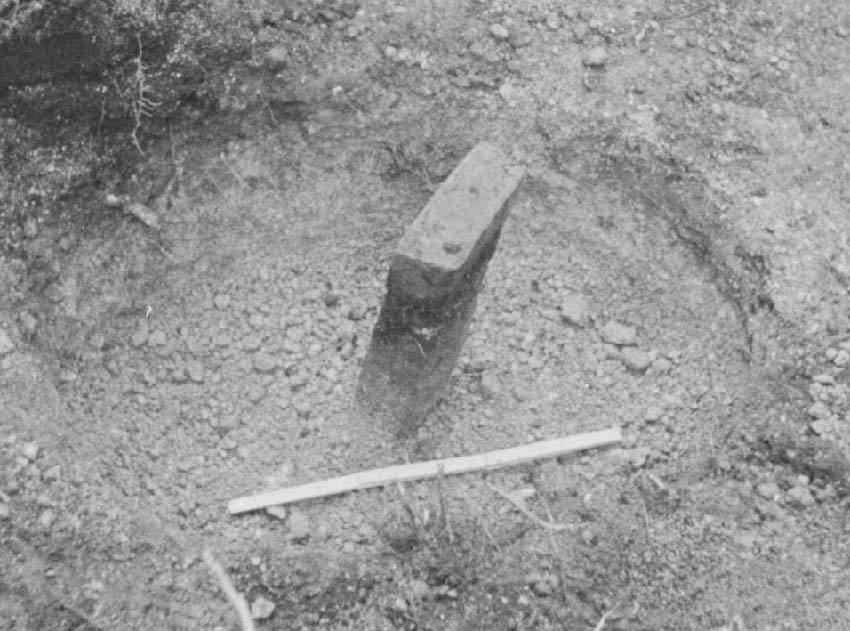
Extensive surveys and partial excavations beginning in the 1960s have revealed burial pits within the circles and around the outer edges of the embankments. Five such pits were discovered 60 centimeters below the ground during a survey of Earthwork Burial Circle 1. One contained a standing stone, suggesting a marked grave. Pits from around and within the other burial circles contained broken pieces of clay figurines (dogu) thought to have a ritual function, circular stone arrangements, traces of red ochre, and a polished stone staff with intricate engravings that may have served some ceremonial function.
The scale of the Kiusu burial circles and the effort that would have been required to complete them have special importance. Earthwork circles like these and the stone circles of Washinoki (Hokkaido), Oyu (Akita), Isedotai (Akita), Komakino (Aomori), and Omori Katsuyama (Aomori), point to the increasing complexity of burial practices and significance of funeral rites from 2000 BCE.
Artifacts on display
Artifacts highlighting different aspects of life during the Jomon period (13,000–400 BCE)—including diet, pottery, stoneworking, and burial practices—from the Kiusu burial circles and other nearby sites can be viewed at the Chitose City Buried Cultural Properties Center. The facility is a 10-minute drive from the Kiusu Earthwork Burial Circles. Admission is free. Some information is provided in English.
(This English-language text was created by the Japan Tourism Agency.)
Omori Katsuyama Stone Circle
More than a thousand stones have been arranged in 77 clusters to form a stone circle at the Omori Katsuyama archaeological site in Hirosaki, Aomori. The stone circle dates from 1000 BCE and is located on a plateau in the foothills of Mt. Iwaki. The mountain and the surrounding area are part of the Tsugaru Quasi-National Park, and visitors can enjoy scenic views from the archaeological site.
The approach
The site can be accessed by either a forested trail with steps or a gently sloping barrier-free path. The forested trail leads past chestnuts and other fruit-bearing trees. These types of trees would have provided sustenance to the prehistoric people that settled the area. Both routes open out onto a clearing with a view of Mt. Iwaki.
The stone circle is in the center of the clearing on an artificially constructed mound. From the center of the circle, there is a clear line of sight to Mt. Iwaki.
Mt. Iwaki and the position of the circle
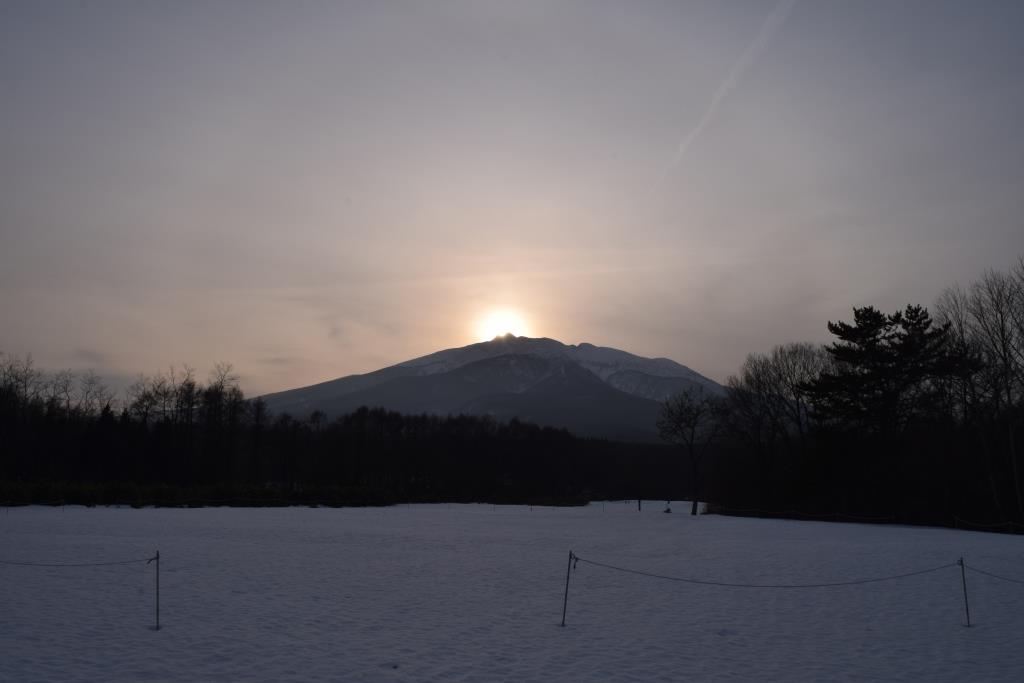
Mt. Iwaki is a stratovolcano shaped similarly to Mt. Fuji, with even, gradually sloping sides. The mountain is worshipped locally and has a Shinto shrine at its peak. On the winter solstice, the sun sets behind the peak of the mountain in clear alignment with the stone circle. This implies that Mt. Iwaki held special significance to the prehistoric communities that lived in the area.
The stone circle as a site of worship
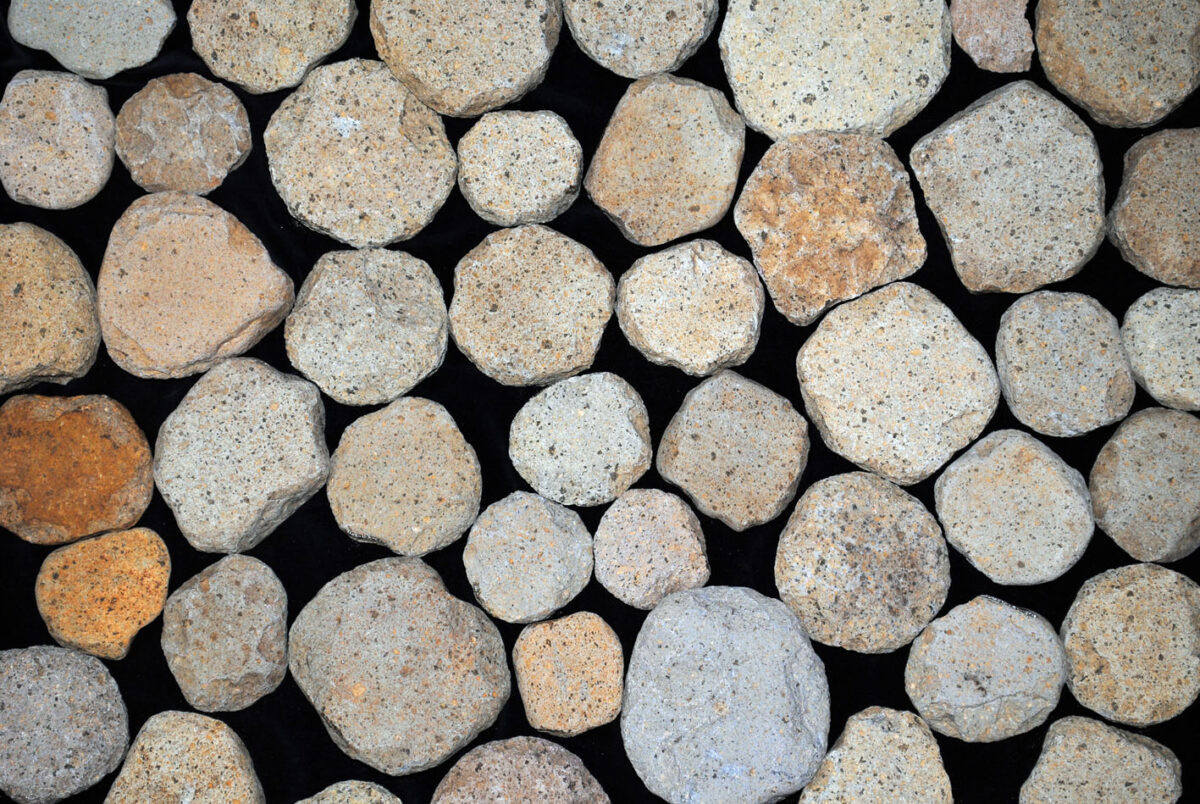
Archaeological discoveries consistent with findings at other ritual sites indicate that the stone circle was a place of worship. Stone staffs, disk-shaped stone objects, and clay figurines have been unearthed throughout the site.
Evidence of a pit dwelling
Towards the far end of the clearing, evidence of a circular pit dwelling with a diameter of 13 meters has been discovered. Due to the large size of the dwelling and the fact that it is the only one discovered at the site, archaeologists believe it would have served as a center for the communities that held rituals here.
Artifacts and related archaeological sites
Artifacts discovered around the Omori Katsuyama Stone Circle are exhibited in the foyer of the Susono District Physical Culture Exchange Center, a 10-minute drive from the site. Some are also displayed at the Hirosaki City Museum, alongside artifacts from other sites in the local area. Other ritual sites in northern Japan include the Komakino Stone Circle (Aomori), the Isedotai Stone Circles (Akita), and the Oyu Stone Circles (Akita).
(This English-language text was created by the Japan Tourism Agency.)
Takasago Burial Site
The Takasago Burial Site (c. 900 BCE) is a large burial site thought to have functioned as a cemetery serving nearby settlements. Archaeological surveys and partial excavations have revealed shell mounds and a burial area with many pit graves. The site is open to the public and the locations of the shell mounds and burial pits are marked. Information about the site is available at the Irie Takasago Museum.
Evidence of elaborate funeral rites
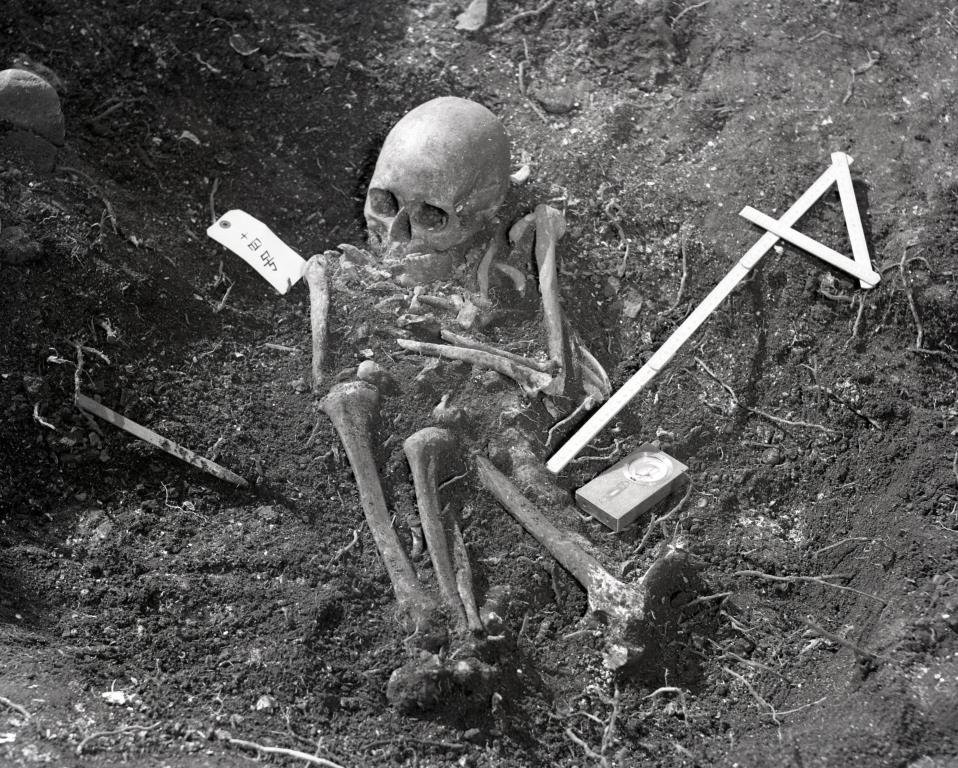
The site provides evidence that ritualistic burial practices became increasingly complex during the later stages of the Jomon period (13,000–400 BCE). The grave pits are similar in shape, and the deceased were interred in almost the exact same position, with their arms and legs bent at an angle and their heads mostly turned to the northwest. Pottery and stone implements and other burial items were found in most of the graves. A circular arrangement of stones was also discovered within the burial area. Inside it were several clay figurines (dogu) and a pot filled with red ochre. Traces of red ochre have been found in burial sites at several locations, suggesting it was used in funeral rites. Red ochre powder may have been scattered over bodies before burial.
Well-preserved remains
Human remains are rarely found in prehistoric burial pits because of the acidic nature of the soil in Japan. Despite this, many intact skeletons have been discovered at the Takasago Site. Here, the deceased were interred in pits within the shell mounds, and the calcium carbonate from the large quantities of bone and shell present in the mounds is thought to have helped preserve the remains.
See more, learn more
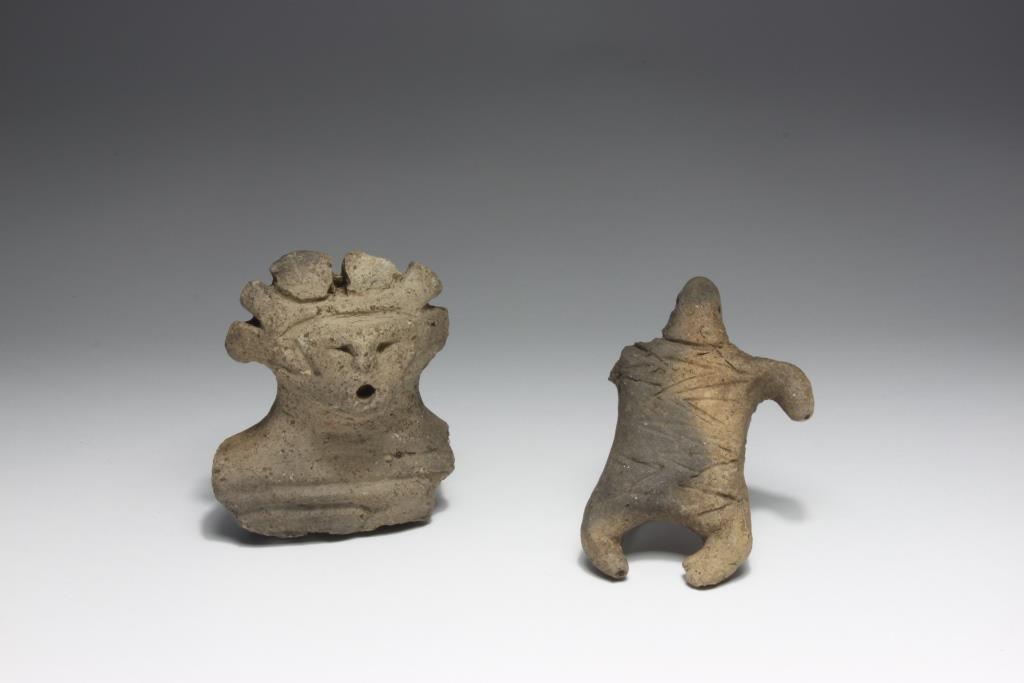
Other artifacts uncovered at the Takasago Site include harpoon heads and other fishing implements carved from deer antler. They are exhibited at the Irie Takasago Museum alongside artifacts found at the nearby Irie Site. An entrance fee is required. Some basic information is in English.
(This English-language text was created by the Japan Tourism Agency.)
Kamegaoka Burial Site
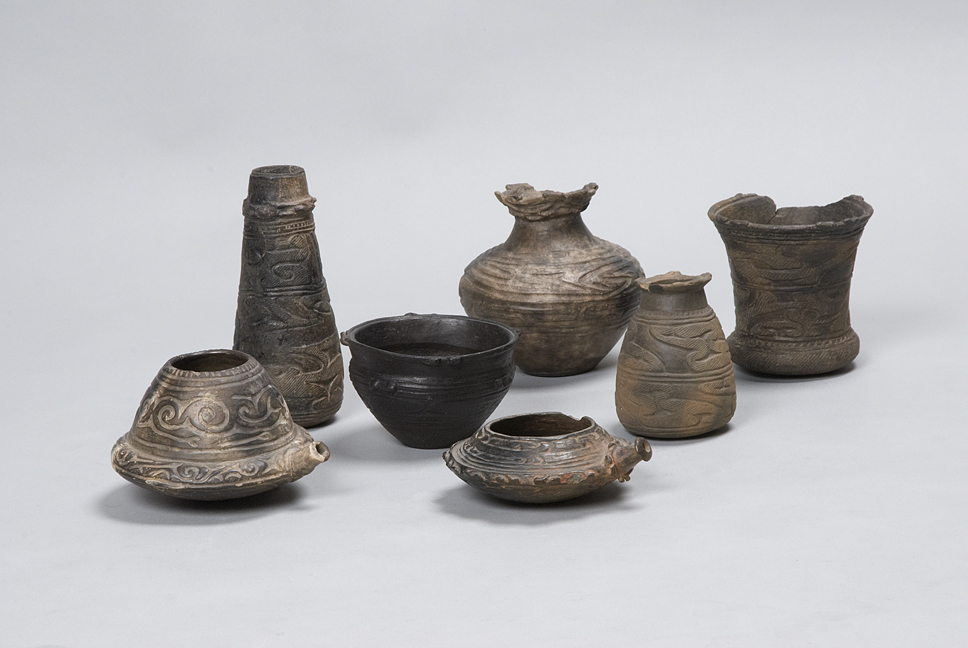
Excavations of the Kamegaoka Burial Site (c. 1000 BCE) have uncovered some of the most famous pottery of the Jomon period (13,000–400 BCE). These artifacts demonstrate mastery of advanced pottery-making techniques and a highly developed sense of design. The term “Kamegaoka style,” from the pottery discovered at this site, is used to refer to a type of late-Jomon pottery made in northern Japan. Many of the world’s leading museums have “Kamegaoka style” pieces in their collections, including the Tokyo National Museum, the British Museum, and the Metropolitan Museum of Art.
Art and spirituality
Excavations have revealed large concentrations of burial pits and ritual deposits of pottery. A wide variety of artifacts have been found in the burial pits and throughout the site including burnished earthenware vessels, polished jade beads, lacquered objects, items woven from plant fiber, and hollow clay figurines with large goggle-like eyes and elaborate headdresses. The offering and interment of such decorative items suggest that late Jomon society was an evolved society with complex rituals and a developed sense of the spiritual world.
Burial sites shared by multiple settlements
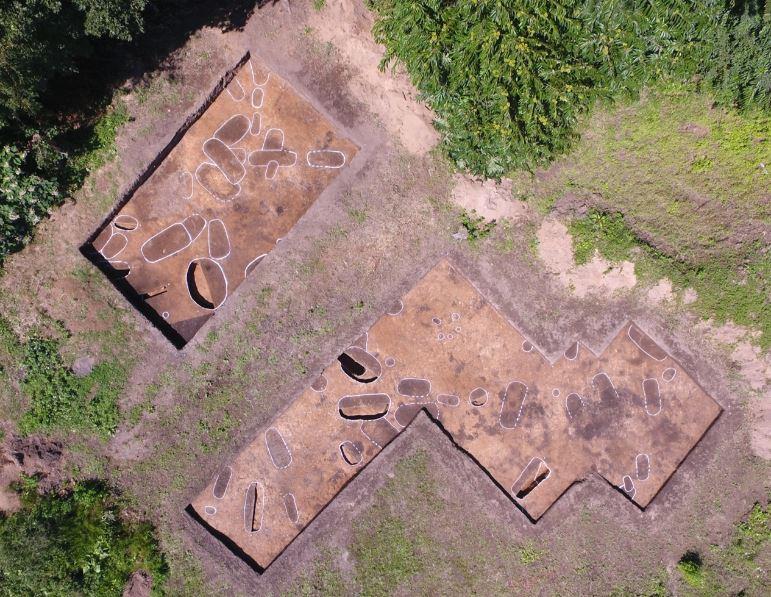
Between 1500 and 400 BCE, burial sites developed outside of individual settlements and were shared by communities. They also became separated from ritual areas. These developments occurred as settlements became dispersed and diminished in scale compared to earlier hub settlements (3000–2000 BCE). The Kamegaoka Burial Site would have served multiple settlements and is an example of a stand-alone burial site from the final stage of the Jomon period.
Adjacent archaeological sites
The Kamegaoka Burial Site has some information boards and a large-scale statue of a goggle-eyed figurine. The Tagoyano Site is nearby and can be reached on foot in five minutes. The Tsugaru City Jomon Dwelling Museum and the Tsugaru City Kizukuri Kamegaoka Archaeological Museum display artifacts from the Kamegaoka Burial Site and other Jomon sites in the area. Farther afield, in Hachinohe, the Korekawa Archaeological Institution displays “Kamegaoka style” artifacts discovered at the Korekawa Site.
(This English-language text was created by the Japan Tourism Agency.)
Korekawa Site
The Korekawa Site is the collective name for three adjoining archaeological sites in Hachinohe, southern Aomori. The sites—the Nakai Site (1000–300 BCE), the Hotta Site (3000–2000 BCE), and the Ichioji Site (4000–2000 BCE)—are located on a terrace beside the Niida River. Surveys of the sites have revealed burial pits, storage pits, deposits of earthenware, evidence of pit dwellings, and vast quantities of lacquerware. Artifacts are exhibited at the Korekawa Archaeological Institution in themed exhibitions that explore life and craftsmanship in the prehistoric communities of northern Japan.
The Nakai Site
The Nakai Site was settled for 700 years at the end of the Jomon period (13,000–400 BCE). At the center of the site there is a plateau where a sun-dial-like stone arrangement has been discovered. This is thought to have served as a ritual area. To the east and west of the plateau, many burial pits have been identified, and to the north and south, there are low wetland areas. Deposits of stone tools, wooden tools, earthenware, lacquerware, and the shells of walnuts and chestnuts have been found from the wetland area. Evidence of pit dwellings has been discovered on the northern edges of the plateau.
The Nakai Site—plants and life at the site
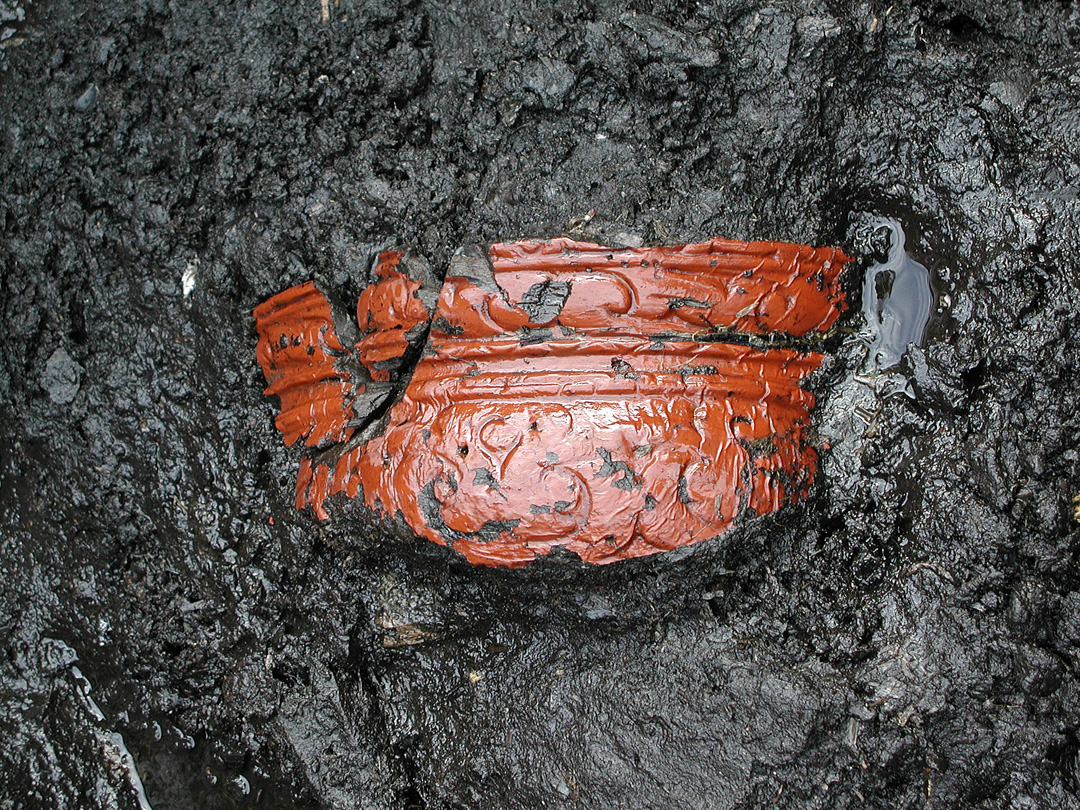
From the study of seeds found preserved at the site, pollen analysis of the soil, and investigations of wooden and lacquered artifacts, archaeologists have been able to identify plants that grew at the settlement and understand how they were used. Walnut trees and horse chestnut trees provided sustenance and timber for pit dwellings and woodworking. Lacquer trees were tapped for sap that was refined to produce lacquer. Spindle trees, the wood of which is flexible, provided the material for making bows. Evidence suggests that inhabitants of the settlement maintained the land surrounding the site in such a way as to keep these plants available.
The Nakai Site—pottery and lacquerware
Excavations of the Nakai Site have yielded many elaborately decorated earthenware vessels and intricately lacquered items. These artifacts demonstrate mastery of advanced pottery and lacquer techniques and convey a highly developed sense of design. They are defined as “Kamegaoka style,” an aesthetic characteristic of the final-Jomon period in northern Japan. The term originates from earthenware discovered at the Kamegaoka Burial Site in northern Aomori. Many of the world’s leading museums, including the Tokyo National Museum, the British Museum, and the Metropolitan Museum of Art, have “Kamegaoka style” pieces in their collections.
The Korekawa Archaeological Institution primarily exhibits artifacts from the Nakai Site and the nearby Kazahari Site 1 (2000–1000 BCE), located on the opposite bank of the Niida River. Among the collection is a designated National Treasure—a solid clay figurine, seated, with clasped hands—and several hundred Important Cultural Properties of Japan.
The Hotta Site
The Hotta Site predates the Nakai Site by 2,000 years. Archaeologists have uncovered earthenware, a series of pits believed to be for storing nuts, and evidence of pit dwellings at this site. The earthenware vessels discovered here typically have wide mouths and are tapered at the bottom. They are decorative, usually with bold patterns, but lack the intricacy and level of finish exhibited by much later pieces from the Nakai Site. Several earthenware artifacts from this site are displayed at the Hachinohe City Museum.
The Ichioji Site
The Ichioji Site is the largest and earliest of the three sites. It predates the Nakai Site by 3,000 years. Archaeologists have found evidence here of pit dwellings and large deposits of pottery. Deep layers of potsherds—1.5 meters at their thickest—were found buried in the earth. These layers also contained the bones of fish and animals, as well as tools such as fish hooks and combs made from bone and antler. The earthenware vessels from this site are tall and cylindrical in form. They are patterned with cord-markings but are less decorative than most pieces from the Hotta and Nakai sites. The Hachinohe City Museum exhibits numerous artifacts from the Ichioji Site.
The Korekawa Archaeological Institution
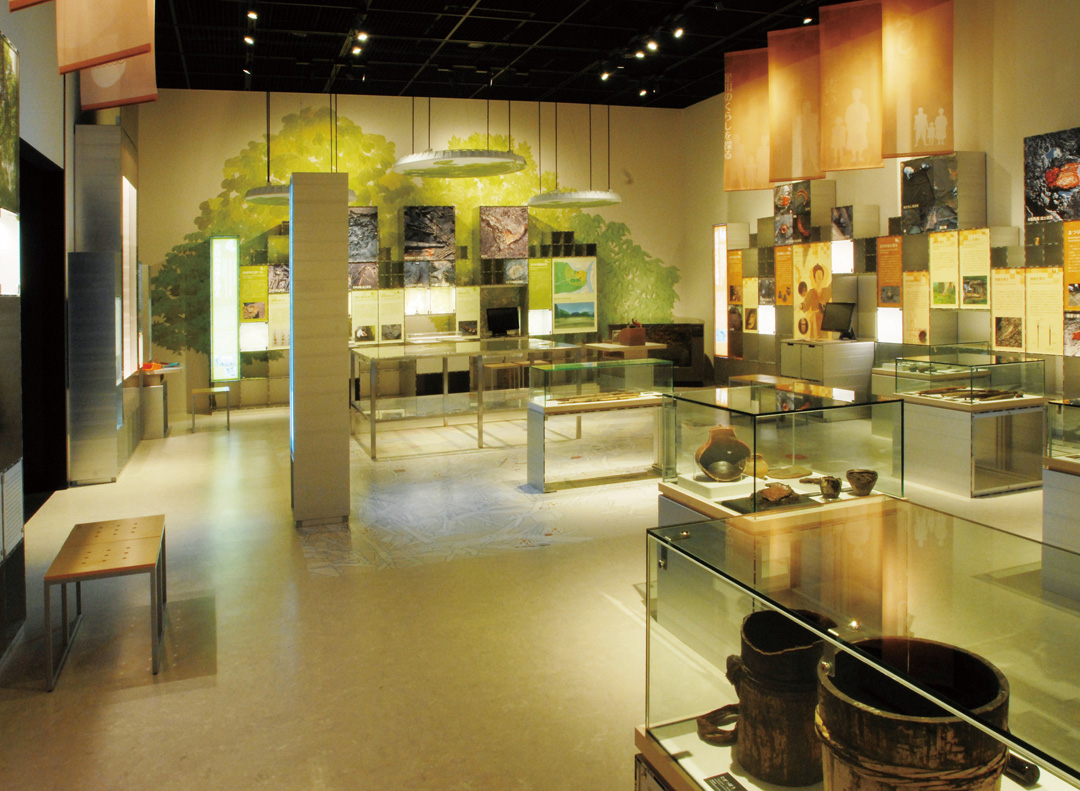
Many fine examples of “Kamegaoka style” artifacts are displayed at the Korekawa Archaeological Institution. Artifacts include earthenware vessels, clay figurines, beads, adornments, and tools such as lacquered bows and baskets. In the theater, a video is screened introducing life in prehistoric Japan. There is also a craft workshop and a shop for souvenirs. Information is provided in English, and additional multilingual information is available via the Pocket Curator app, which can be downloaded on site.
Related archaeological sites
Several of the Jomon Prehistoric Sites in Northern Japan are located in Aomori Prefecture, including the Kamegaoka Burial Site, the Komakino Stone Circle, the Sannai Maruyama Site, and the Futatsumori Site. Nearby in Iwate Prefecture, the Goshono Site can be combined easily with a visit to the Korekawa Site.
(This English-language text was created by the Japan Tourism Agency.)
Choshichiyachi Site (Associated sites)
The Choshichiyachi Site has yielded one of the earliest-known shell mounds (c. 6000 BCE) in northern Japan. The discovery provides insight into the diet and livelihood of early coastal communities and the environmental factors that shaped life in prehistoric Japan.
Sea levels and the shoreline
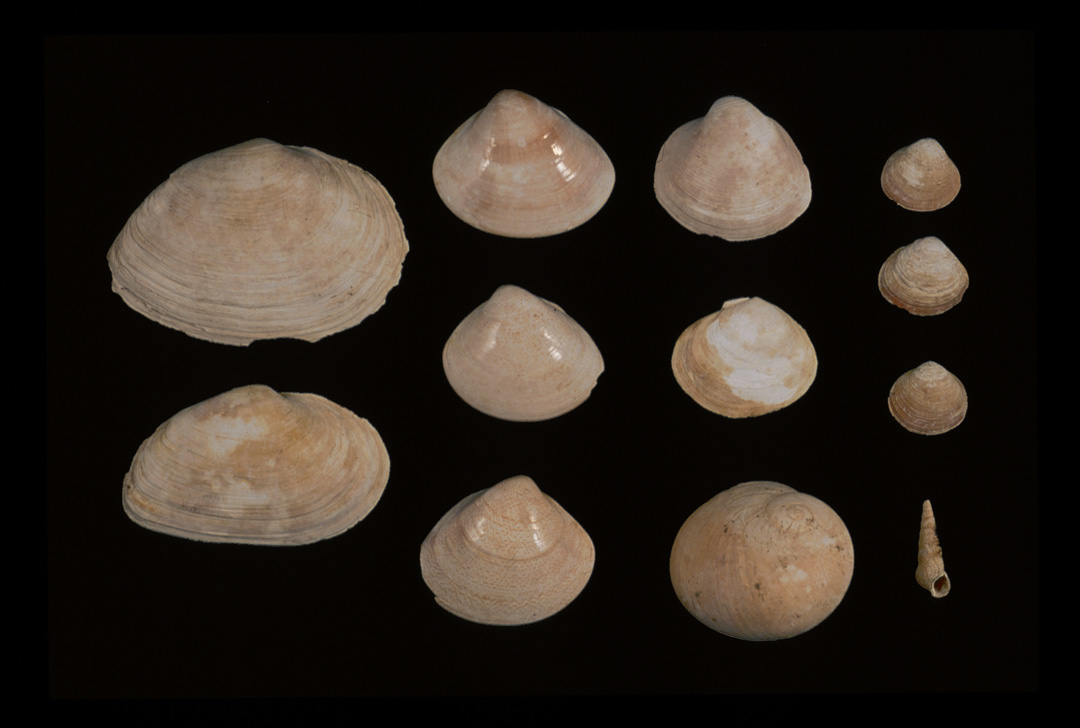
The archaeological site is on a plateau overlooking the floodplains of the Gonohe River, several kilometers from the coast. Eight thousand years ago, the Choshichiyachi Site would have overlooked a bay. After the last ice age ended more than 10,000 years ago, temperatures rose gradually, sea levels rose, and the shoreline advanced inland. This created shallow bays and vast tidal flats, ideal for fishing and gathering clams.
Diet and livelihood
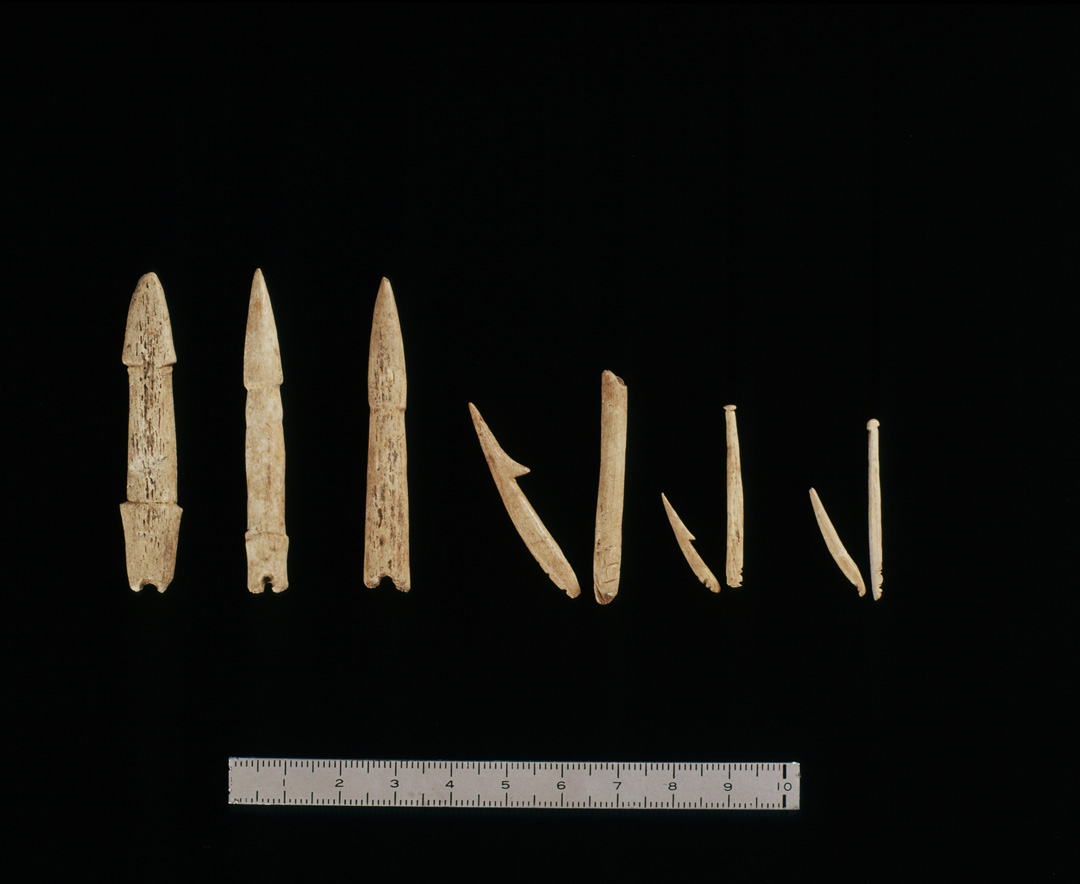
A diverse range of fishing implements has been discovered at the site, providing evidence of a rich fishing culture. The artifacts include combination fish hooks made from bone and antler, harpoon heads, and stone net sinkers. Surveys of the shell mound have yielded the shells of approximately 30 shellfish species and the bones of almost 20 fish species. Bird and mammal bones have also been identified.
Hachinohe City Museum
Artifacts from the Choshichiyachi Site are displayed at Hachinohe City Museum. Exhibits introduce the history of Hachinohe from prehistoric to modern times. A small admission fee is charged. Some information is provided in English.
Related archaeological sites
Other sites in northern Japan where shell mounds have been discovered include the Kitakogane Site (Hokkaido), Irie Site (Hokkaido), Takasago Burial Site (Hokkaido), Tagoyano Site (Aomori), and the Futatsumori Site (Aomori).
(This English-language text was created by the Japan Tourism Agency.)
Washinoki Stone Circle (Associated sites)
The Washinoki Stone Circle, in the town of Mori in southern Hokkaido, is the island’s largest known stone circle, with a circumference of 37 meters. It dates from around 2000 BCE and displays similarities with stone circles discovered in Aomori and Akita from a similar period. Archaeologists believe the stone circles in northern Tohoku and southern Hokkaido are evidence of a shared culture between the two regions.
The composition of the circle
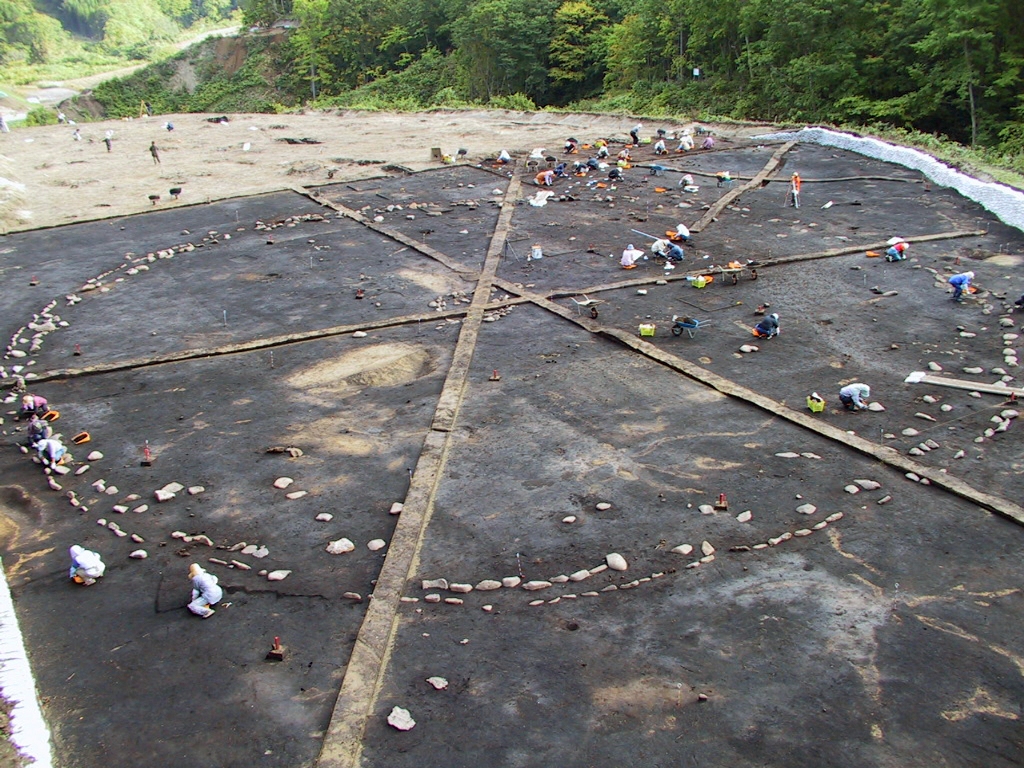
The circle is composed of two outer rings and an oval-shaped stone arrangement in the center. Many of the 602 stones that comprise the circle are dug into the ground and positioned upright or pointing inwards at different angles. The stones would have been gathered from the mouth of the Katsura River, about a kilometer away. Burial pits and artifacts such as miniature clay objects in the shapes of bells have been found near the circle.
Saving the circle
The stone circle, built on top of a hill, was discovered in 2003 ahead of construction work for a highway. Plans to bulldoze the hill were abandoned after the local community campaigned to preserve the circle. Instead, a tunnel was constructed, with great care taken not to displace the stones or the layer of soil in which they are buried. Vibrations were constantly monitored, and some of the tunneling work had to be done without power tools or machinery. The stone circle remains undisturbed in its original location, now above a highway.
Visiting the circle

Due to its location, the archaeological site is not open to the general public. It can only be visited on tours organized by the Mori Town Office for Archaeological Excavation and Research, a center with exhibits about the stone circle and the artifacts uncovered at the site. The exhibition space at the center is free of charge. Information is provided only in Japanese.
(This English-language text was created by the Japan Tourism Agency.)
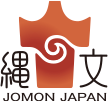
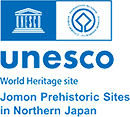
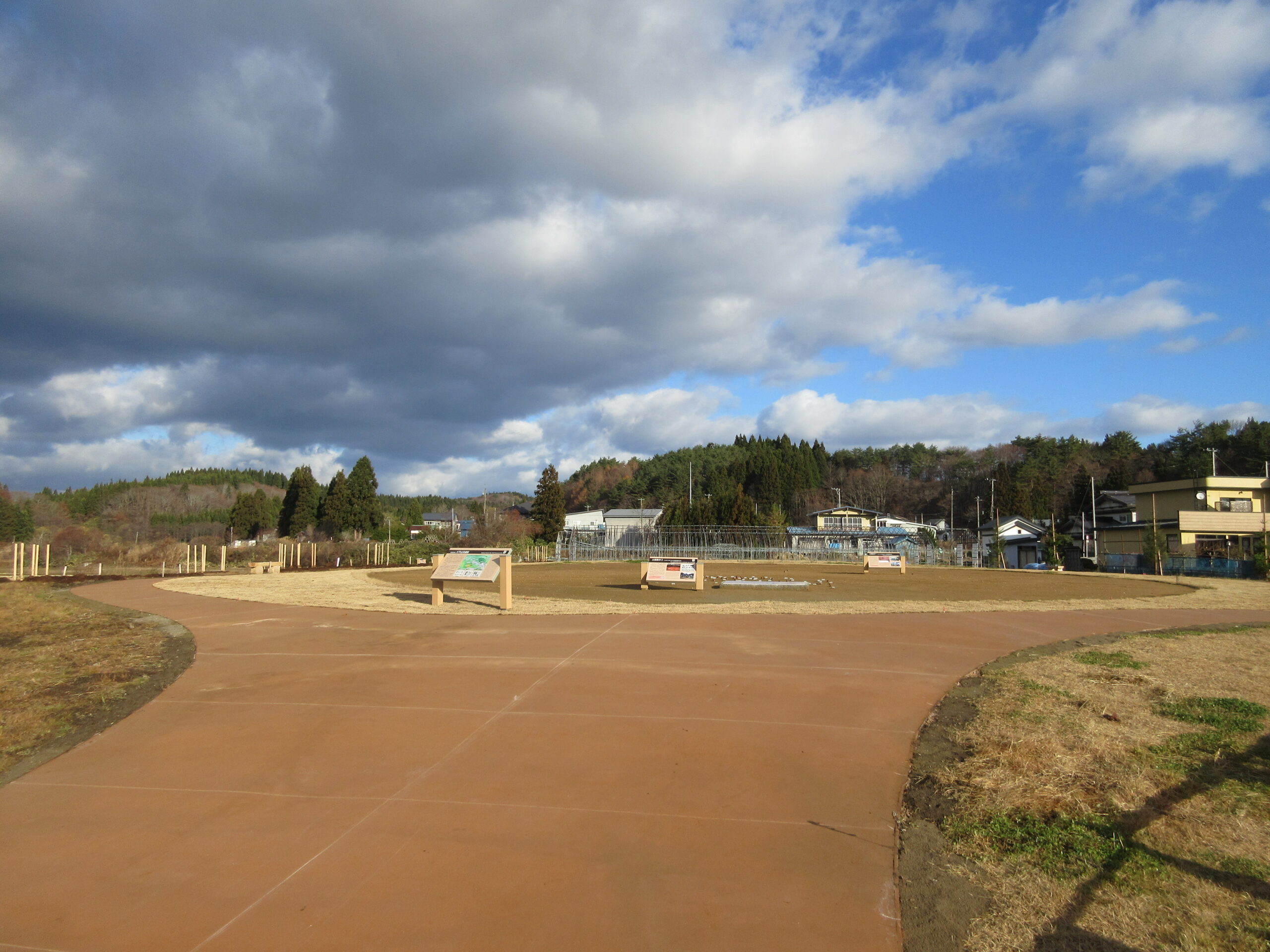
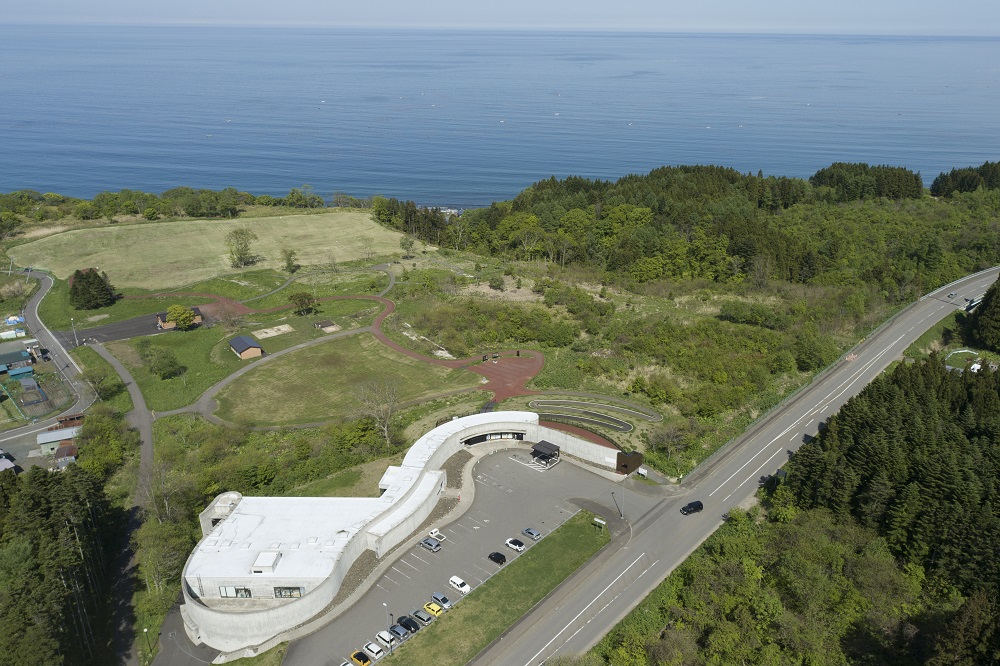

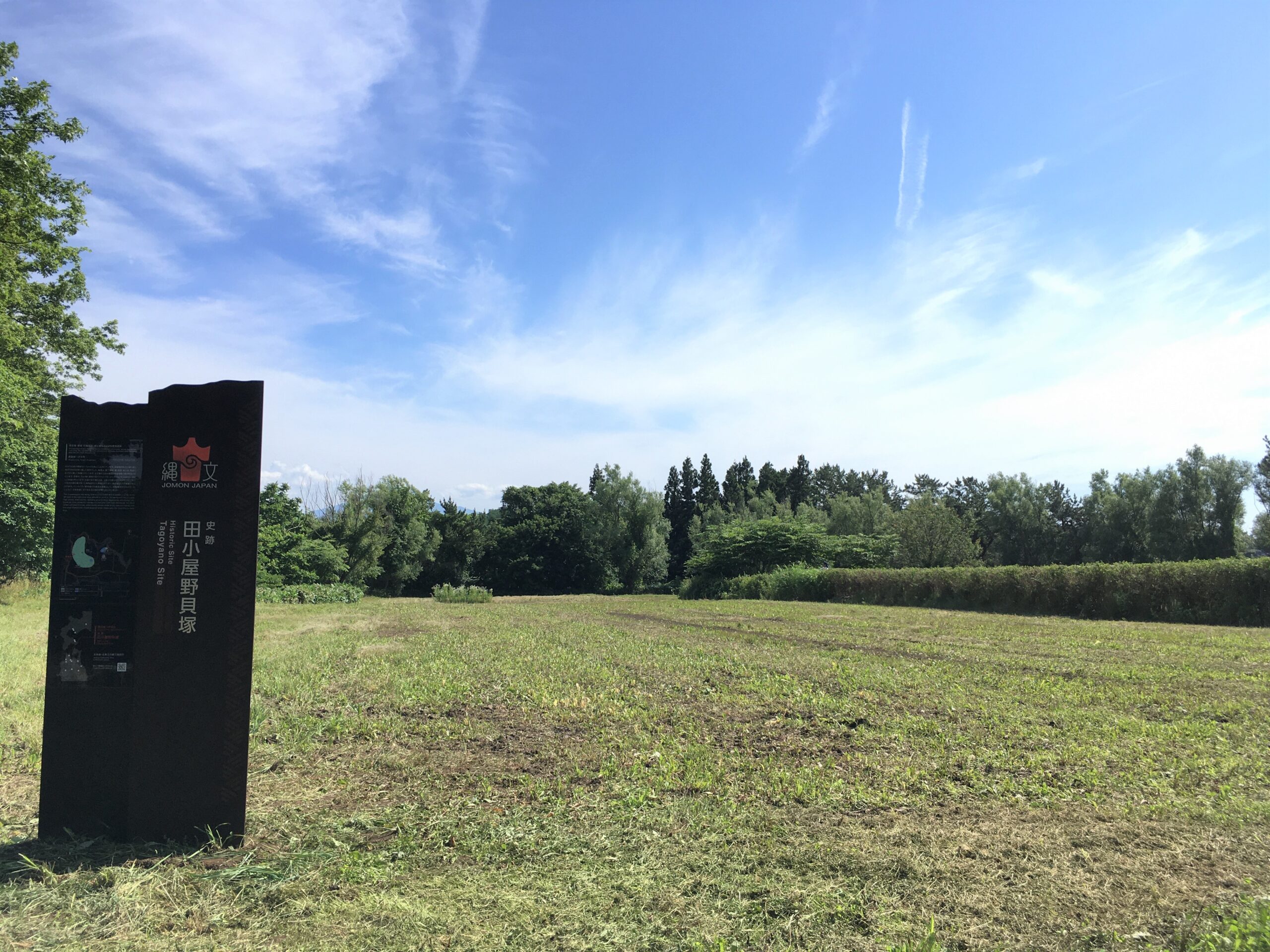



.jpg)





-scaled.jpg)



